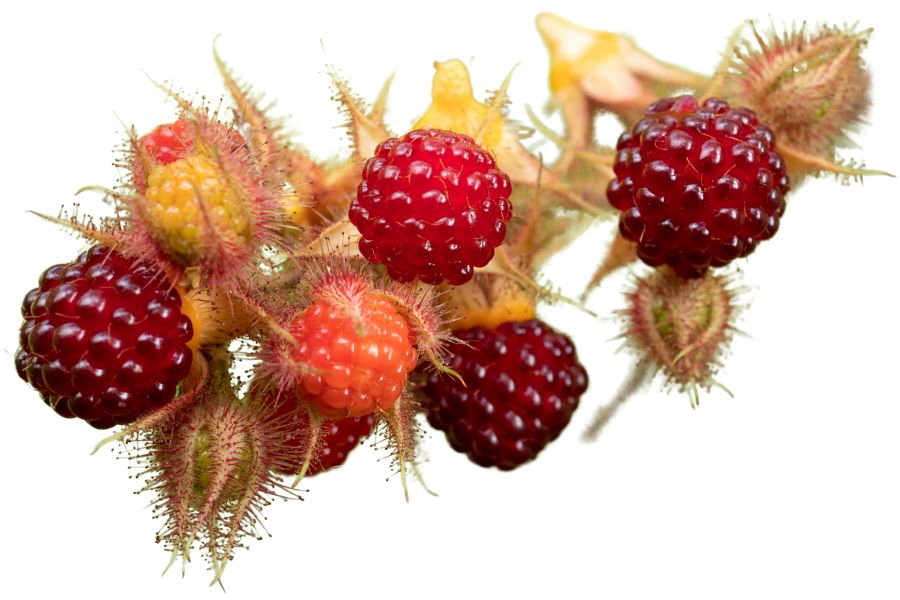Virginia’s woods and meadows are home to a wide variety of edible plants. Wild leeks pop up early in the season, with broad leaves and a sharp onion scent. Later in the year, black walnuts drop from tall trees, their thick shells hiding rich, oily nuts.
Not everything edible grows above ground. Groundnut vines cling to shrubs near creeks, while their underground tubers were once a staple food source. These types of finds hint at the range of hidden resources the state holds.
Many edible plants in Virginia go unnoticed unless you know what to spot. The variety stretches far beyond just roots and nuts. Learning what’s out there opens the door to bringing home more than you’d expect.
What We Cover In This Article:
- The Edible Plants Found in the State
- Toxic Plants That Look Like Edible Plants
- How to Get the Best Results Foraging
- Where to Find Forageables in the State
- Peak Foraging Seasons
- The extensive local experience and understanding of our team
- Input from multiple local foragers and foraging groups
- The accessibility of the various locations
- Safety and potential hazards when collecting
- Private and public locations
- A desire to include locations for both experienced foragers and those who are just starting out
Using these weights we think we’ve put together the best list out there for just about any forager to be successful!
A Quick Reminder
Before we get into the specifics about where and how to find these plants and mushrooms, we want to be clear that before ingesting any wild plant or mushroom, it should be identified with 100% certainty as edible by someone qualified and experienced in mushroom and plant identification, such as a professional mycologist or an expert forager. Misidentification can lead to serious illness or death.
All plants and mushrooms have the potential to cause severe adverse reactions in certain individuals, even death. If you are consuming wild foragables, it is crucial to cook them thoroughly and properly and only eat a small portion to test for personal tolerance. Some people may have allergies or sensitivities to specific mushrooms and plants, even if they are considered safe for others.
The information provided in this article is for general informational and educational purposes only. Foraging involves inherent risks.
The Edible Plants Found in the State
Wild plants found across the state can add fresh, seasonal ingredients to your meals:
Milkweed (Asclepias syriaca)
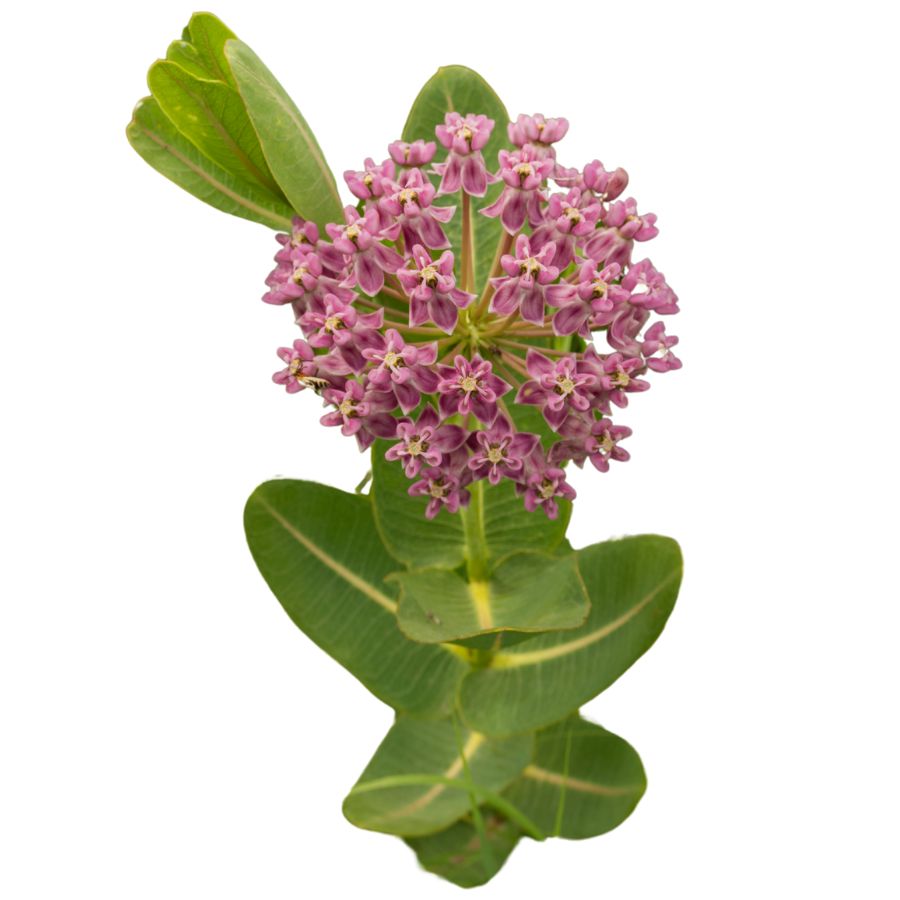
Known for its thick stems, broad leaves, and clusters of pinkish-purple flowers, common milkweed is sometimes called silkweed or butterfly flower. When you snap a stem or leaf, it releases a milky sap that helps you tell it apart from other plants that can be harmful.
If you want to try it in the kitchen, focus on gathering the young shoots, the tightly closed flower buds, and the small, immature pods. These parts have a mild, slightly sweet flavor when cooked, and their soft texture makes them a good addition to soups, sautés, and fritters.
Getting it ready to eat takes a little care, since boiling the plant parts in several changes of water helps remove bitterness and unwanted compounds. Some people also like to steam the buds or fry the pods lightly to bring out their best taste.
Although monarch caterpillars rely on this plant for survival, it has a long history of being used by people as well. Watch out for lookalikes like dogbane, though, since they share the same milky sap but are dangerously toxic if eaten.
Groundnut (Apios americana)

Groundnut is also called potato bean or Indian potato, and it grows as a climbing vine with clusters of pinkish-purple flowers. The part most people go for is the underground tuber, which looks a bit like a small, knobby chain of beads.
The flavor is richer than a regular potato, with a nutty, earthy taste and a dense, almost chestnut-like texture when cooked. It holds up well in soups and stews, or you can boil and mash it like a root vegetable.
Some people slice it thin and roast it until crisp, while others slow-cook it to bring out a sweeter taste. The vine also produces beans, but the root is what’s usually eaten.
There are a few vines that resemble groundnut, but many of those don’t have the same distinctive flower clusters or tend to lack the beadlike roots. Always make sure you’re digging up the right plant before cooking it.
Jerusalem Artichoke (Helianthus tuberosus)
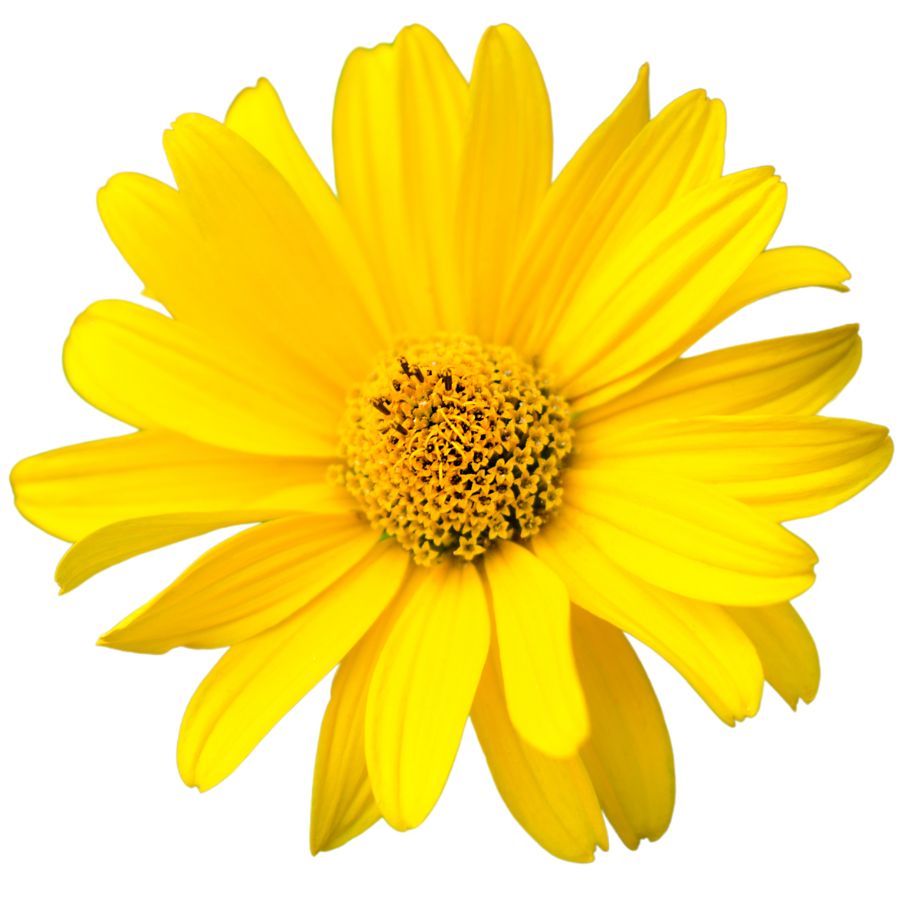
Jerusalem artichoke grows tall with sunflower-like blooms and has knobby underground tubers. The tubers are tan or reddish and look a bit like ginger root, though they belong to the sunflower family.
The part you’re after is the tuber, which has a nutty, slightly sweet flavor and a crisp texture when raw. You can roast, sauté, boil, or mash them like potatoes, and they hold their shape well in soups and stir-fries.
Some people experience gas or bloating after eating sunchokes due to the inulin they contain, so it’s a good idea to try a small amount first. Cooking them thoroughly can help reduce the chances of digestive discomfort.
Sunchokes don’t have many dangerous lookalikes, but it’s important not to confuse the plant with other sunflower relatives that don’t produce tubers. The above-ground part resembles a small sunflower, but it’s the knotted, underground tubers that are worth digging up.
Pawpaw (Asimina triloba)
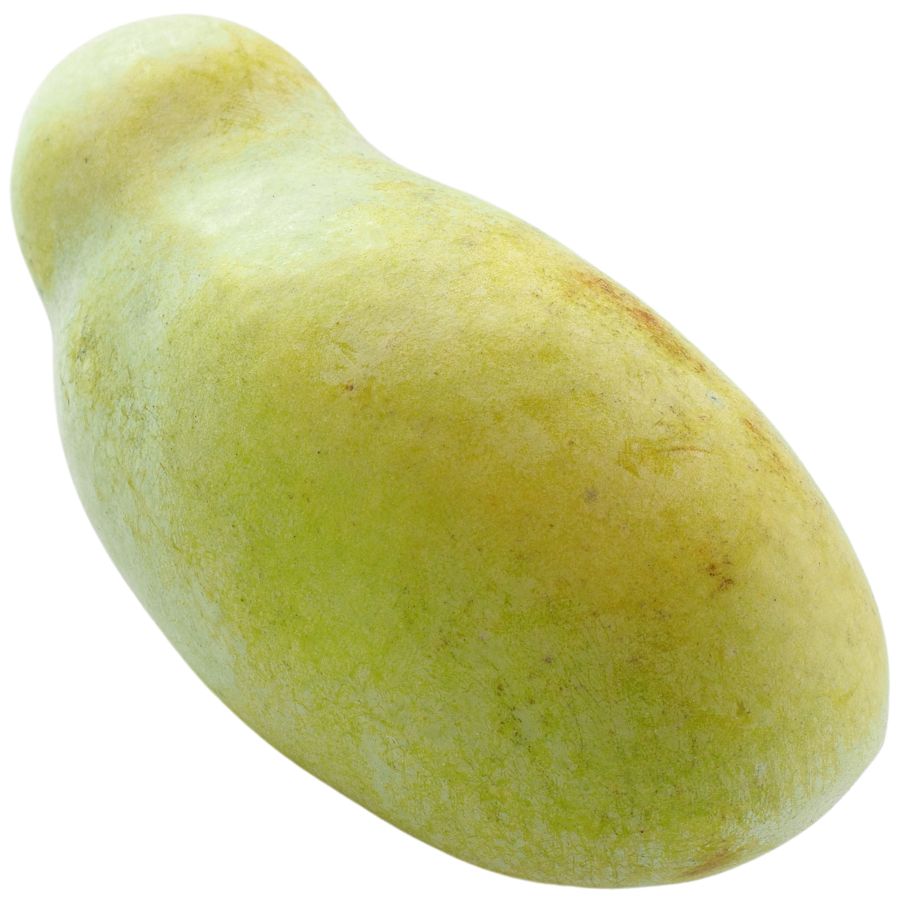
The pawpaw grows fruits that are green and shaped a little like small mangoes. Inside, the soft yellow flesh tastes like a blend of banana, mango, and melon, with a custard-like texture that melts in your mouth.
If you are comparing it to similar plants, keep in mind that young pawpaw trees can look a little like young magnolias because of their large leaves. True pawpaws grow fruits with large brown seeds tucked inside, while magnolias do not produce anything that looks or tastes similar.
You can eat the flesh straight out of the skin with a spoon, or mash it into puddings, smoothies, and even homemade ice cream. Some people also like to freeze it into cubes for later, although it does tend to brown quickly once exposed to air.
Stick to eating the soft inner flesh. Make sure not to ingest the skin and seeds of the fruit because they contain compounds that can upset your stomach.
This fruit is that it was a favorite snack of Native Americans and early explorers long before it started showing up in backyard gardens.
Spicebush (Lindera benzoin)
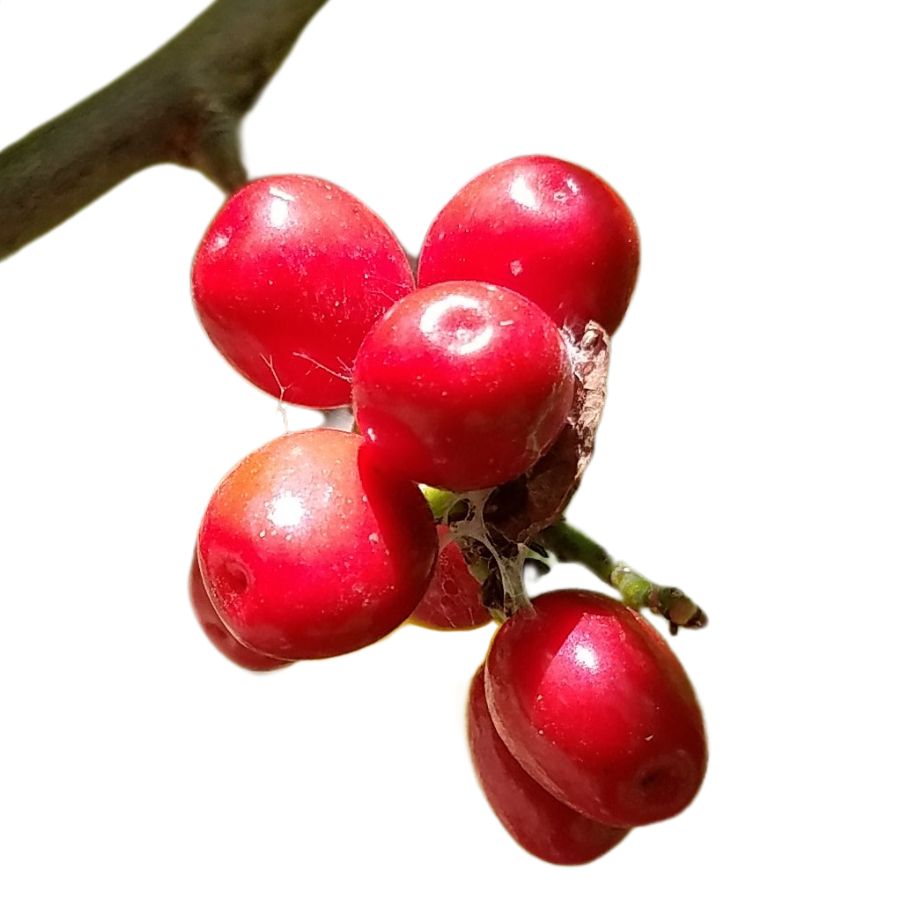
Spicebush has smooth-edged leaves that release a spicy citrus scent when crushed, and it produces clusters of red berries that grow close to the stem. Those berries, along with the young twigs and leaves, are all edible and flavorful.
The berries are especially valued for their warm, peppery kick and are often dried and ground as a seasoning. You can steep the leaves and twigs into tea or simmer them into broths.
Avoid confusing it with lookalikes like Carolina allspice, which has larger, thicker leaves and lacks the same aromatic quality. Its berries also differ in size and internal seed structure.
Spicebush has a long history of use in traditional cooking for its mild numbing effect and warming flavor. Only the berries, leaves, and tender twigs should be consumed—avoid the bark and roots.
Carolina Rose (Rosa carolina)
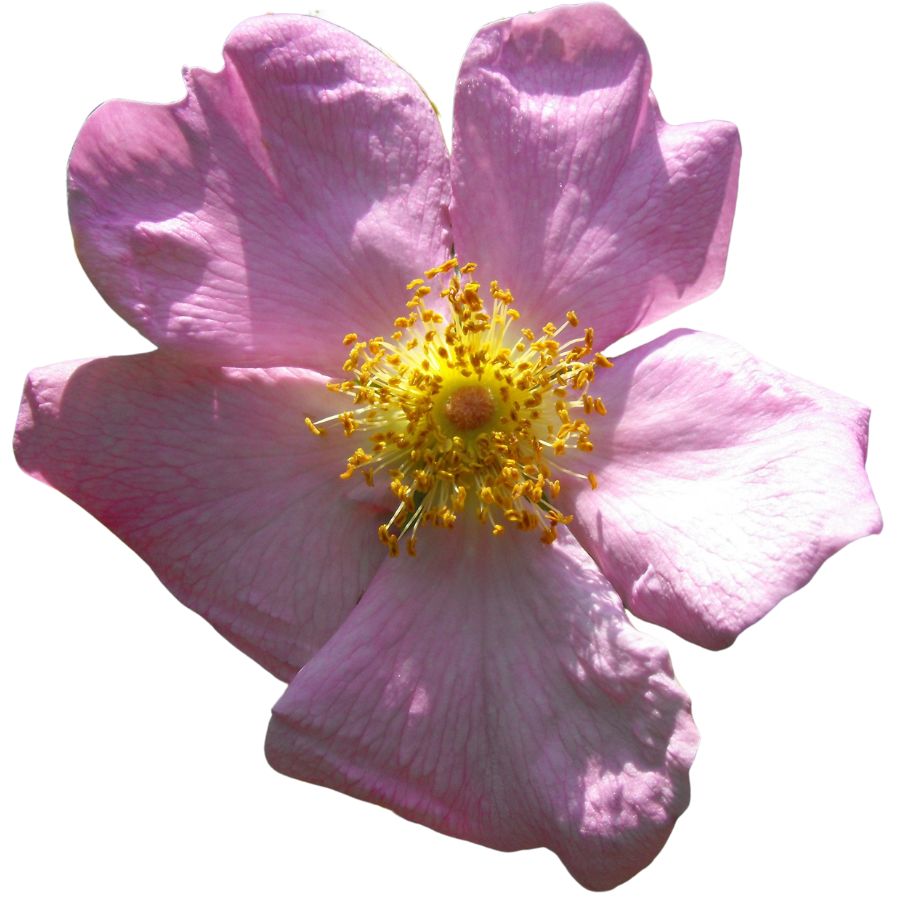
Carolina rose has bright pink flowers with a flat, open shape and typically five petals arranged around a yellow center. Its thorns are straight and needle-like, unlike the curved ones you’d find on some other wild roses.
The plant produces red-orange hips that are safe to eat once the seeds and hairs inside are removed. They’re tangy and slightly sweet, making them good for jellies, teas, or simmered into sauces.
You can also use the petals, which are soft and delicate with a faintly sweet flavor that works well fresh or preserved in sugar. Don’t eat the leaves, stems, or seeds—they won’t harm you in small amounts but offer nothing good.
One thing to watch out for is pasture rose, which looks similar but usually grows taller and has more toothed leaves. Learning the shape of the flowers and the habit of the plant will help you avoid mixing them up.
Black Walnut (Juglans nigra)
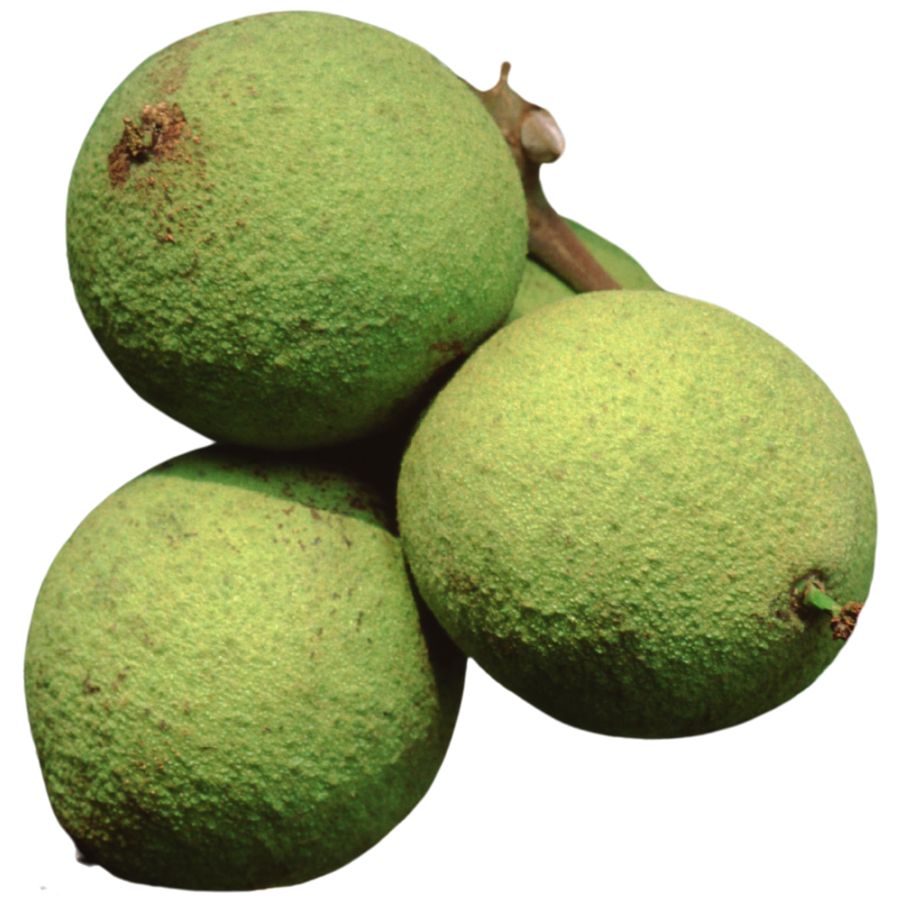
The nuts of the black walnut, sometimes called American walnut or eastern black walnut, have a tough outer husk and a deeply ridged shell inside. When you crack them open, you will find a rich, oily seed with an earthy, slightly bitter flavor that sets them apart from the sweeter English walnut.
It is easy to confuse black walnut with butternut, another tree with compound leaves and rough bark. If you check the nuts closely, black walnut fruits are round with a thick green husk, while butternuts are more oval and sticky.
When you get your hands on the nuts, the common ways to prepare them include baking them into cookies, sprinkling them over salads, or grinding them into a strong-tasting flour. The seeds themselves have a firm, almost chewy texture when raw and become crunchy after roasting.
Only the inner seed is eaten, while the outer husk and shell are discarded because they contain compounds that can irritate your skin. A fun fact about this plant is that even the roots and leaves produce a chemical called juglone, which can make it hard for other plants to grow nearby.
Beech (Fagus grandifolia)
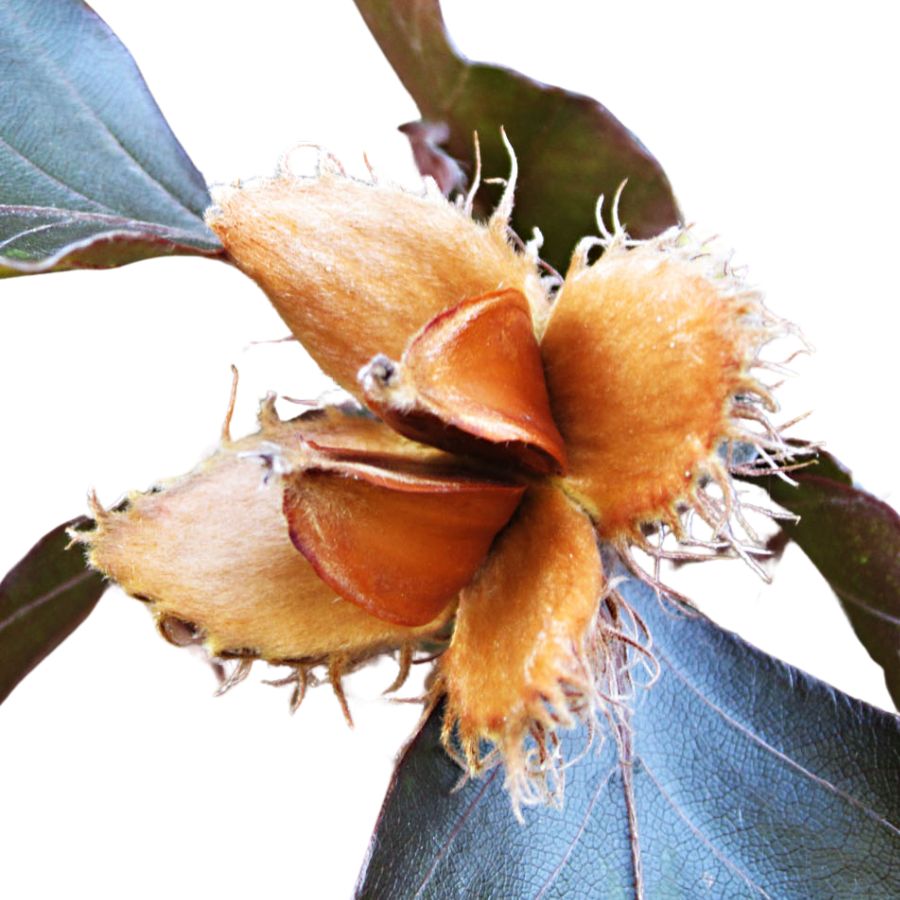
From the American beech tree—also nicknamed white beech—you can collect small, three-sided nuts that are tightly enclosed in a spiny outer husk. They’re best roasted or pan-dried to bring out their buttery texture and mellow flavor.
The husks naturally open on their own once the nuts are ready, and you’ll often find two shiny brown seeds inside. Don’t eat them raw in large amounts, since they contain small amounts of oxalic acid that cooking neutralizes.
Beech trees are easy to confuse with chestnut trees at a glance, but chestnut leaves have longer tapering tips and the husks are far more heavily armored with spines. Avoid picking from horse chestnut, which has poisonous seeds that look similar.
Once prepared, the nuts can be added to soups or ground into a coarse flour for baked goods. Nothing else from the tree is eaten—only the seeds inside the husks are used.
Eastern Redbud (Cercis canadensis)
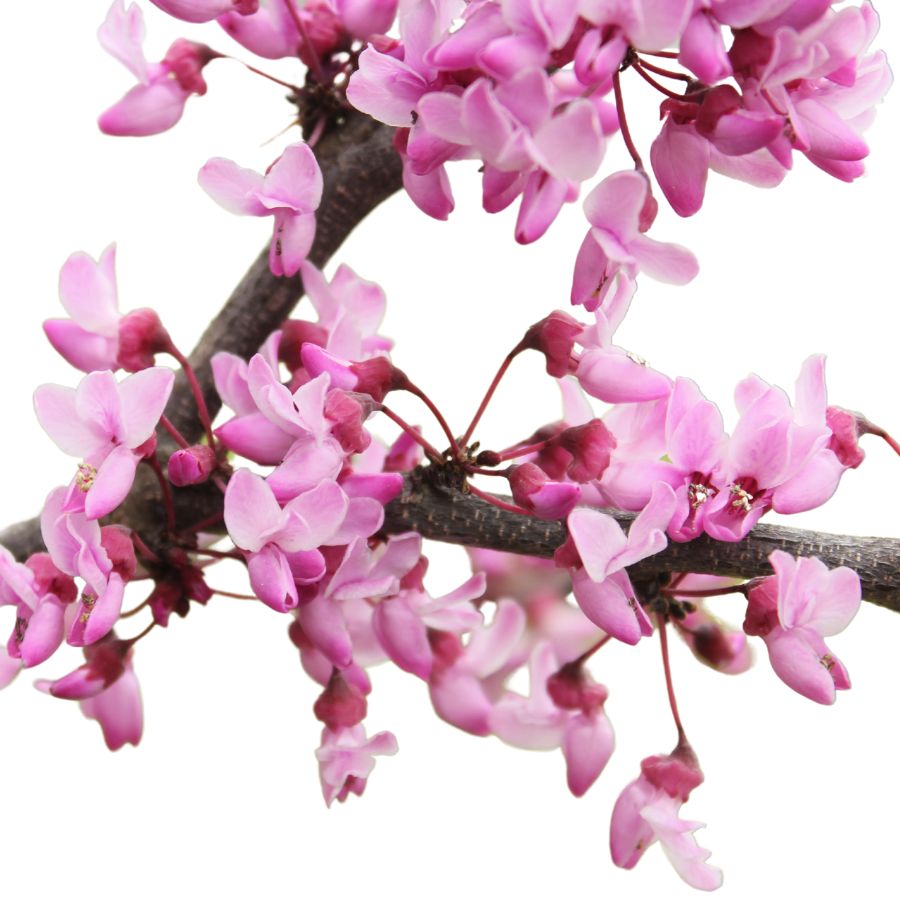
The small, pinkish-purple flowers of the eastern redbud grow directly from the branches and even the trunk. These blooms are edible raw and have a slightly tangy, pea-like flavor that works well in salads or as a garnish.
You can also eat the young seed pods when they’re still flat and tender. They taste somewhat like snow peas and can be lightly steamed, stir-fried, or pickled.
Avoid older seed pods, which become tough and fibrous. Also be aware that while the flowers and young pods are safe to eat, the mature seeds and bark are not consumed.
Some people sprinkle the blossoms into baked goods for a splash of color and a mild floral note. Others like to candy the flowers, though they lose some of their fresh bite in the process.
Wild Lettuce (Lactuca canadensis)

Tall, leafy stalks with jagged edges and a milky sap mark the plant known as wild lettuce. You will usually notice the pale green stems and purple-tinged veins that make it stand out from other wild greens.
The taste of wild lettuce is noticeably bitter, especially once the plant matures. If you want a milder flavor, you can cook the young leaves by boiling or sautéing them to reduce some of the bitterness.
Only the young leaves and tender parts of wild lettuce can be eaten, and you should avoid the mature stems and roots. Older plants tend to become too tough and unpleasant to eat, even when cooked.
Some plants, like common dandelions and prickly lettuce, can look a little similar to wild lettuce at first glance. If you crush the stem and see a thick white sap and no pronounced dandelion-like flower, you are most likely looking at wild lettuce.
Wild Bergamot (Monarda fistulosa)
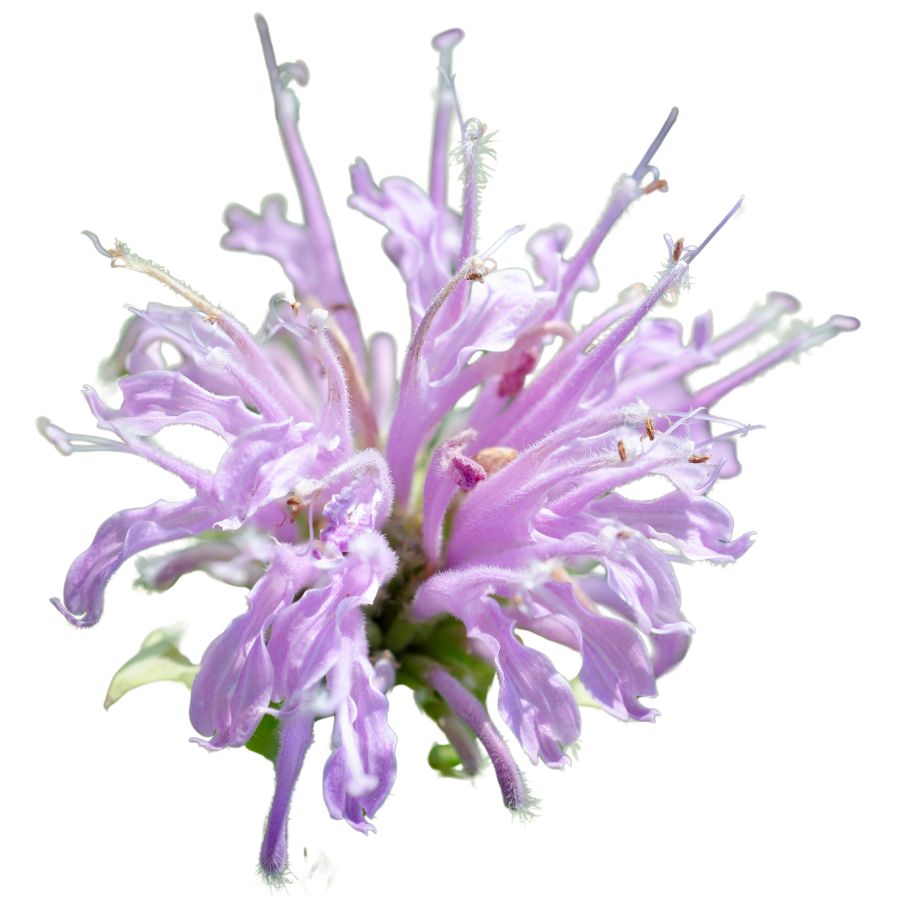
Wild bergamot has clusters of lavender-colored flowers and opposite leaves that smell like thyme when crushed. Its flavor leans herbal and minty, with a little bitterness that works well in marinades.
The flower heads are shaggy and irregular, and the plant’s square stem helps tell it apart from lookalikes like spotted horsemint.
In recipes, it’s most often dried and steeped or blended into herb mixes.
Both leaves and petals can be eaten, though most people avoid the stems. Don’t eat it in large amounts raw—it’s strong and can be overpowering.
It’s related to mint, and that shows in how fast the flavor develops when heat is applied. You’ll get the most aroma if you bruise the leaves before using them.
Common Mallow (Malva neglecta)
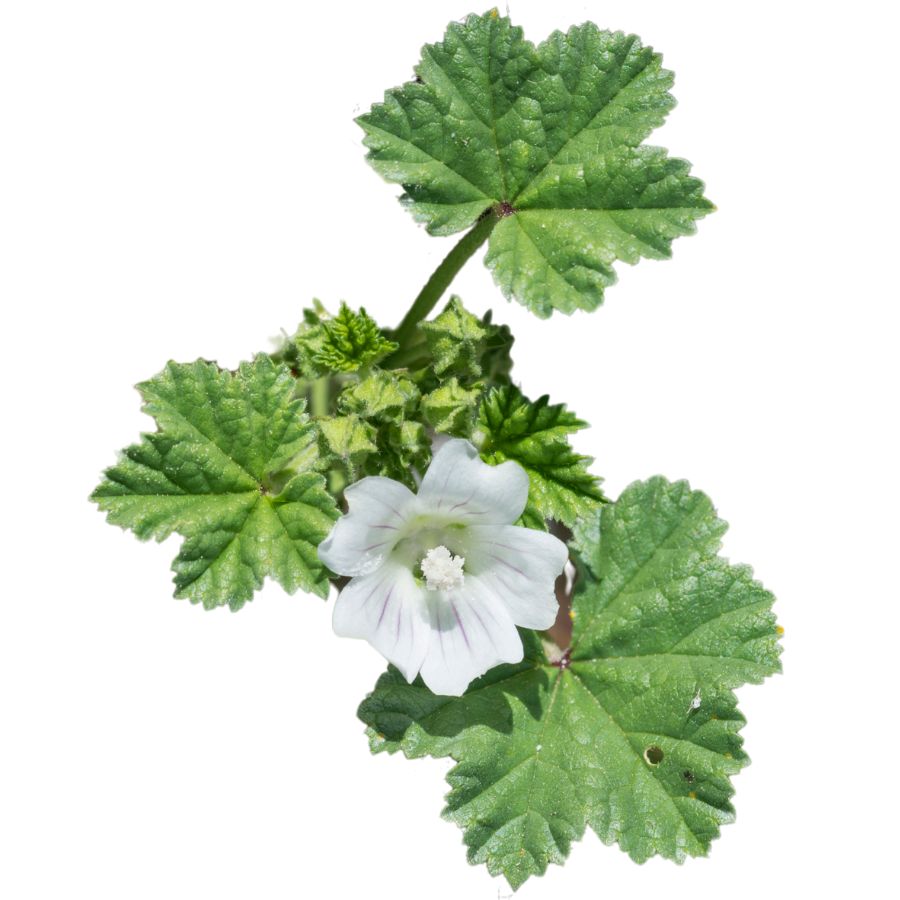
Mallow, often called common mallow or cheeseweed, grows low to the ground and spreads with round, crinkled leaves that look a bit like tiny lily pads. It produces small pale purple or pink flowers with five delicate petals, and the seed pods are shaped like little green wheels.
The leaves, flowers, and immature seed pods of mallow are all edible, offering a mild, slightly sweet flavor and a soft, somewhat mucilaginous texture. Some people add the leaves to salads, toss them into soups for thickening, or quickly sauté them with garlic for a simple side dish.
When gathering mallow, make sure you do not confuse it with young deadly nightshade plants, which can sometimes grow in similar weedy areas but have very different flower and fruit structures. Mallow is safe to eat, but it tends to absorb pollutants from the soil, so be cautious about harvesting from roadsides or contaminated areas.
An interesting thing about mallow is that it was traditionally used for soothing sore throats and irritated skin because of its natural slimy quality. If you are foraging for food and medicine, mallow is a versatile and easy plant to start with once you are confident in your identification.
Ground Ivy (Glechoma hederacea)
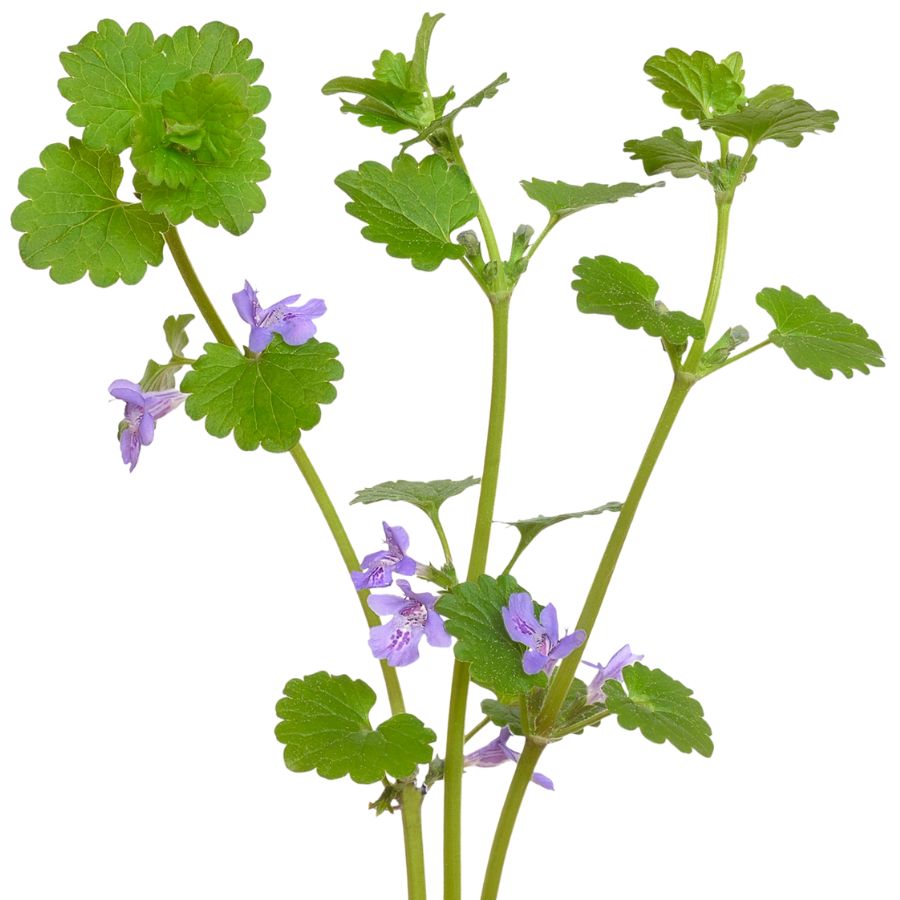
You’re looking at ground ivy if you find a vining plant with scalloped leaves and clusters of tiny bluish-purple flowers hugging the ground. It’s also called creeping charlie or tunhoof, and it grows in dense mats that spread rapidly.
The leaves and stems are edible and have a sharp, minty-bitter flavor that intensifies when dried. Some people use them sparingly in herb butters or infuse them into vinegar for a bold, green tang.
Watch out for lookalikes like henbit, which has more rounded upper leaves and lacks the strong herbal smell. Crushed ground ivy gives off a camphor-like scent that makes it easier to distinguish once you know what to expect.
Avoid foraging near roadsides or polluted soils since this plant easily absorbs heavy metals. Stick to clean patches, and only use the above-ground parts—roots aren’t eaten and older leaves can become too tough.
Purple Deadnettle (Lamium purpureum)
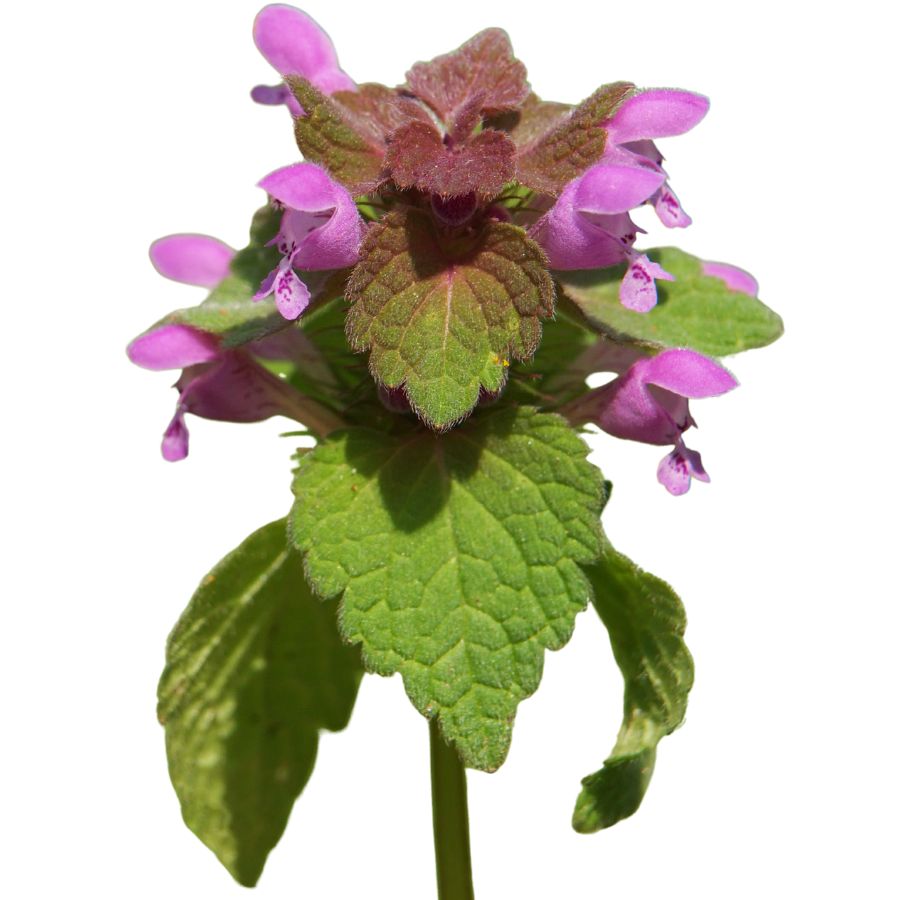
Those soft, fuzzy leaves with reddish tops and delicate pink flowers belong to purple deadnettle, a mint-family plant that grows in stacked tiers. The leaves are somewhat triangular and become more deeply colored near the top.
You can eat the upper leaves and flowering tops raw or cooked, and they have a very mild flavor, almost bland. They’re often tossed into pestos or dried for later use in soups.
Henbit is the plant people most often mistake it for, but henbit’s leaves grow directly from the stem without petioles. Purple deadnettle also has more of a pointed leaf shape compared to henbit’s rounded ones.
It’s entirely edible, but you’ll want to avoid the lower leaves once they get tough and stringy. The plant isn’t toxic, but some people find it mildly irritating in large amounts.
Wineberry (Rubus phoenicolasius)
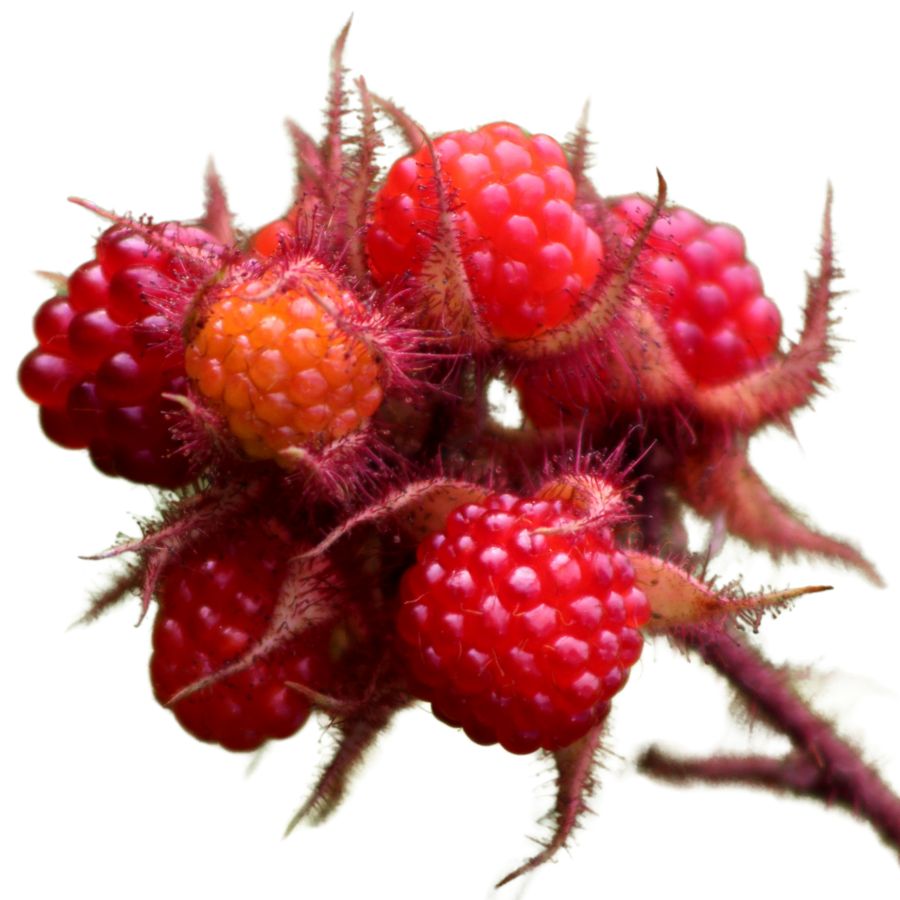
If you’ve ever tasted wineberry, also called Japanese wine raspberry, you would know how its tart-sweet flavor sets it apart from common raspberries. The small red fruits are soft, juicy, and covered in fine hairs that give them a slightly sticky feel.
The plant has arching canes with reddish hairs and sharp thorns, and its fruit develops inside a sticky calyx that peels back as it ripens. While it resembles red raspberry, wineberry fruit grows in a tighter, more spherical cluster and has a glossier look.
The only part you want is the ripe fruit—avoid the stems and leaves, which are not edible. Most people eat the ripe fruits raw or make jam, syrup, or pie filling with it.
Be aware that wineberry spreads aggressively and can take over patches of land quickly. Despite being invasive, wineberry produces flavorful fruit that’s hard to ignore once you’ve tasted it.
Common Evening Primrose (Oenothera biennis)
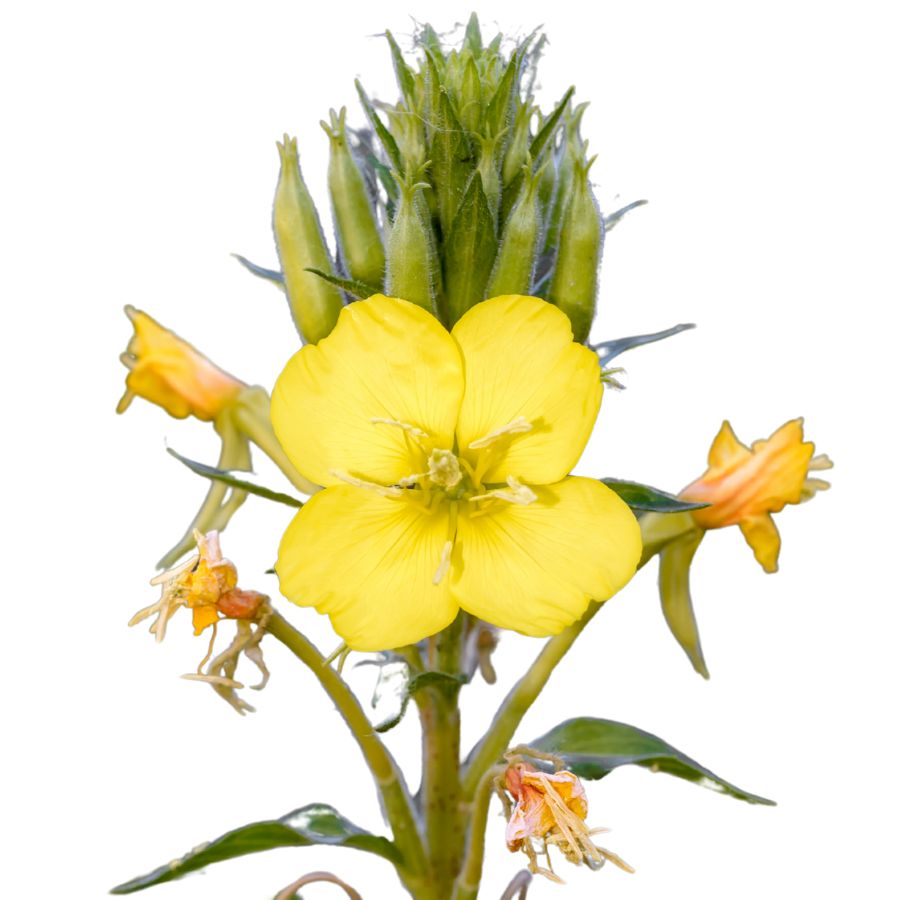
The bright yellow blooms of common evening primrose, or hog weed as it’s also called, only open in low light and tend to wilt by morning. It has a coarse stem and elongated leaves that spiral upward, with buds that cluster near the top.
Its root has a taste similar to salsify and works well roasted or baked. Flower buds and young leaves are sometimes boiled like spinach to reduce bitterness.
Some parts of the plant resemble helenium, which is not safe to eat—helenium leaves are narrower and more aromatic when crushed. The seeds of common evening primrose can be ground into a paste or flour-like mix for cooking.
Though many parts of the plant are used in food, the flower stalks get tough quickly and aren’t usually eaten. Stick with the first-year roots and early foliage for better flavor and texture.
Daylily (Hemerocallis fulva)

Bright orange flowers known as daylily, tiger lily, or ditch lily can sometimes be mistaken for other plants that are not safe to eat. True daylilies have long, blade-like leaves that grow in clumps at the base and a hollow flower stem, while their toxic lookalikes often have solid stems or different leaf patterns.
When it comes to flavor, daylily buds have a crisp texture and a mild taste that some people compare to green beans or asparagus. The flowers are tender and slightly sweet, which makes them popular for tossing into salads or lightly stir-frying.
Most people use the unopened flower buds in cooking, but the young shoots and tuber-like roots are also gathered for food. Always make sure you are harvesting from clean areas, because roadside plants can carry pollutants that are not safe to eat.
A few important cautions come with daylilies, since some people experience digestive upset after eating large amounts. Start by tasting a small quantity first to see how your body reacts before eating more.
Japanese Knotweed (Reynoutria japonica)
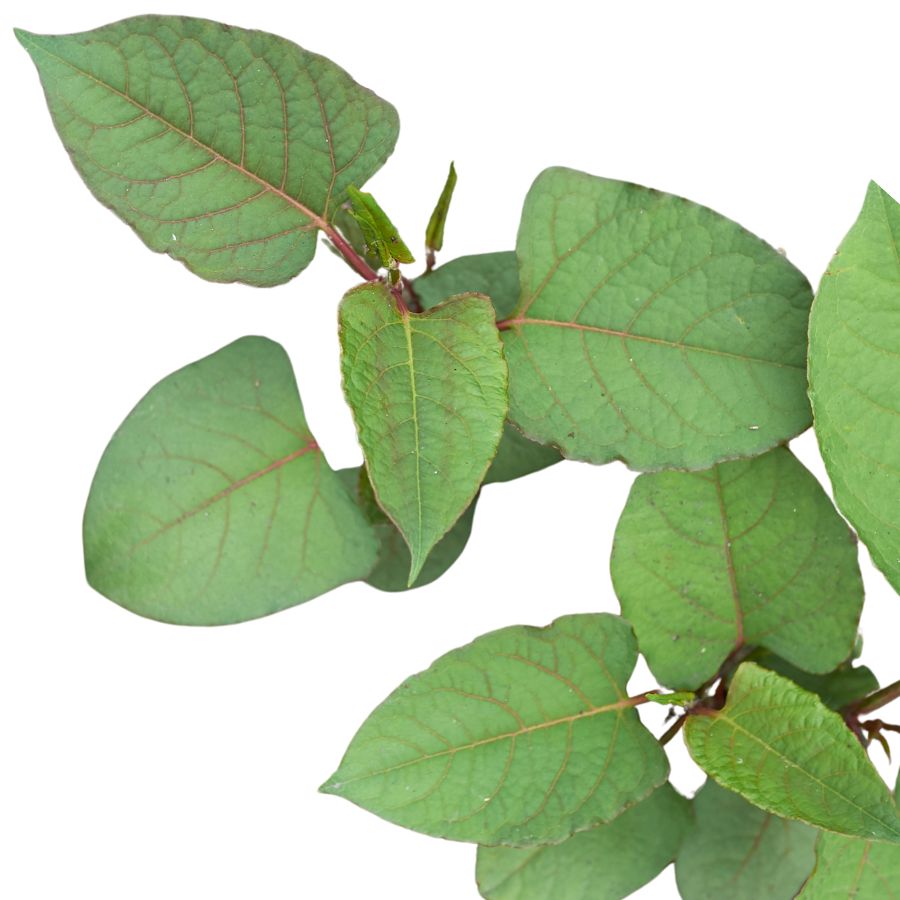
With its reddish-green stems and large spade-shaped leaves, Japanese knotweed—also called monkey weed—can be a surprisingly tasty wild ingredient. It has a strong, lemony flavor that mellows with cooking and pairs well with fruit.
People sometimes confuse it with giant ragweed or pokeweed, but knotweed stems are smooth, hollow, and ridged at the nodes, unlike the solid or grooved stems of those toxic lookalikes. Always focus on the young, flexible shoots, discarding any that feel stiff or woody.
Simmered into jams, blended into dressings, or used in baked goods, this plant transforms into something tart and refreshing. Peeled stalks can also be quick-pickled or sautéed.
You don’t want to eat the leaves or roots, and it’s smart to avoid areas sprayed with herbicides. Despite being considered a nuisance plant, it’s highly versatile in the kitchen.
White Clover (Trifolium repens)

White clover shows up with three-part leaves and round flower heads that cluster into soft white pom-poms. As the blossoms age, they can shift toward a tan or pinkish tint.
The tender leaves are usually cooked into soups, while the dried flowers make a mild, earthy tea. You can also dry the flower heads to grind into meal for blending with flour.
All parts above ground are usable, but the leaves and blossoms are the most common foragers go for. Make sure you don’t confuse it with less common, ornamental clover relatives that aren’t edible.
There’s a compound in moldy clover called coumarin that can cause issues if ingested in large quantities. Stick to fresh or properly dried plant material.
American Persimmon (Diospyros virginiana)
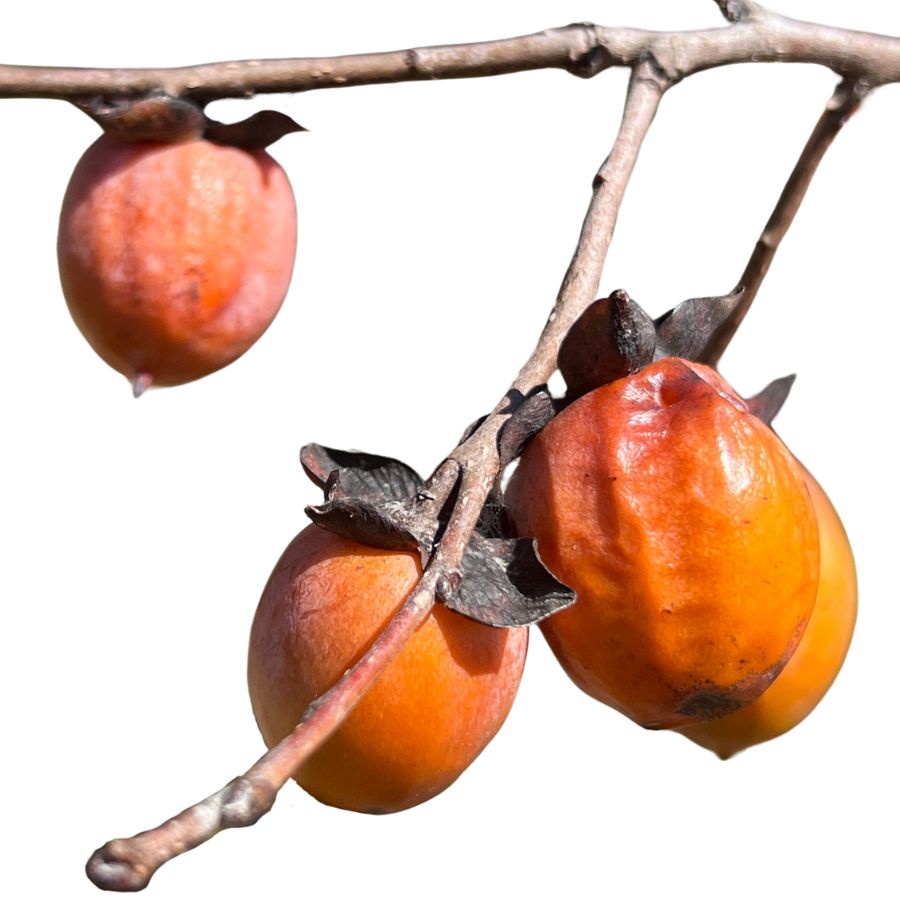
Persimmon, sometimes called American persimmon or common persimmon, grows as a small tree with rough, blocky bark and oval-shaped leaves. The fruit looks like a small, flattened tomato and turns a deep orange or reddish color when ripe.
If you bite into an unripe persimmon, you will quickly notice an extremely astringent, mouth-drying effect. A ripe persimmon, on the other hand, tastes sweet, rich, and custard-like, with a soft and jelly-like texture inside.
You can eat persimmons fresh once they are fully ripe, or you can cook them down into puddings, jams, and baked goods. Some people also mash and freeze the pulp to use later for pies, breads, and sauces.
Wild persimmons can sometimes be confused with black nightshade berries, but nightshade fruits are much smaller, grow in clusters, and stay dark purple or black. Only the ripe fruit of the persimmon tree should be eaten; the seeds and the unripe fruit are not edible.
Toxic Plants That Look Like Edible Plants
There are plenty of wild edibles to choose from, but some toxic native plants closely resemble them. Mistaking the wrong one can lead to severe illness or even death, so it’s important to know exactly what you’re picking.
Poison Hemlock (Conium maculatum)
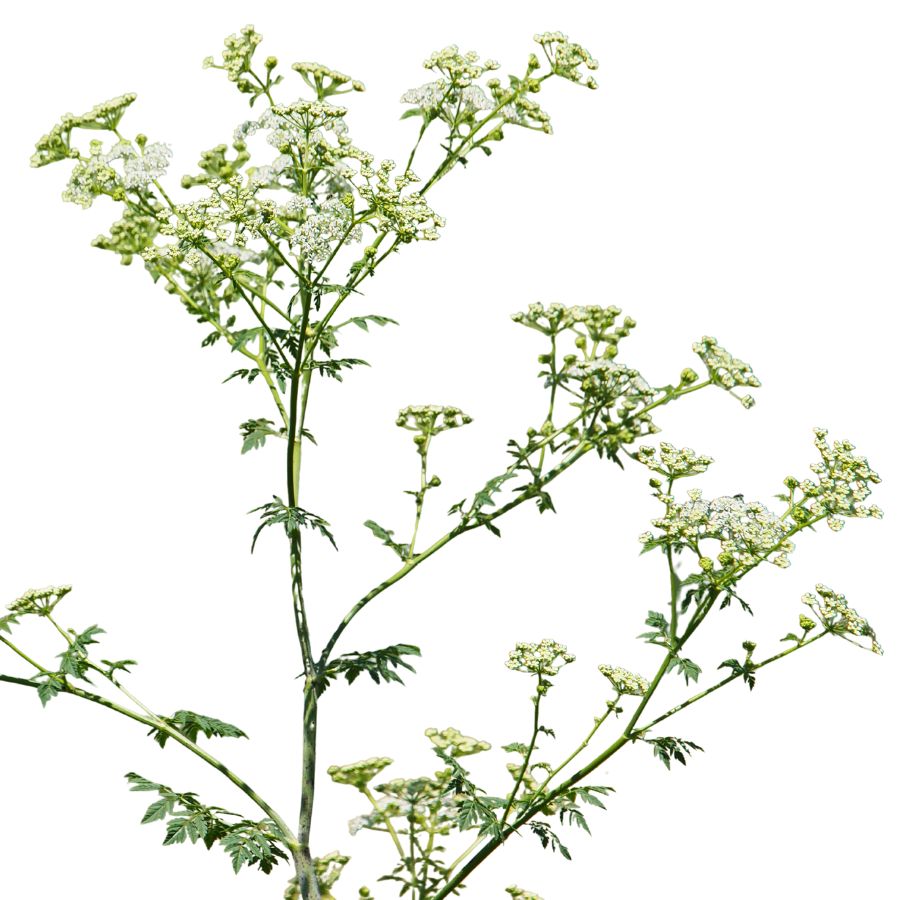
Often mistaken for: Wild carrot (Daucus carota)
Poison hemlock is a tall plant with lacy leaves and umbrella-like clusters of tiny white flowers. It has smooth, hollow stems with purple blotches and grows in sunny places like roadsides, meadows, and stream banks.
Unlike wild carrot, which has hairy stems and a dark central floret, poison hemlock has a musty odor and no flower center spot. It’s extremely toxic; just a small amount can be fatal, and even touching the sap can irritate the skin.
Water Hemlock (Cicuta spp.)
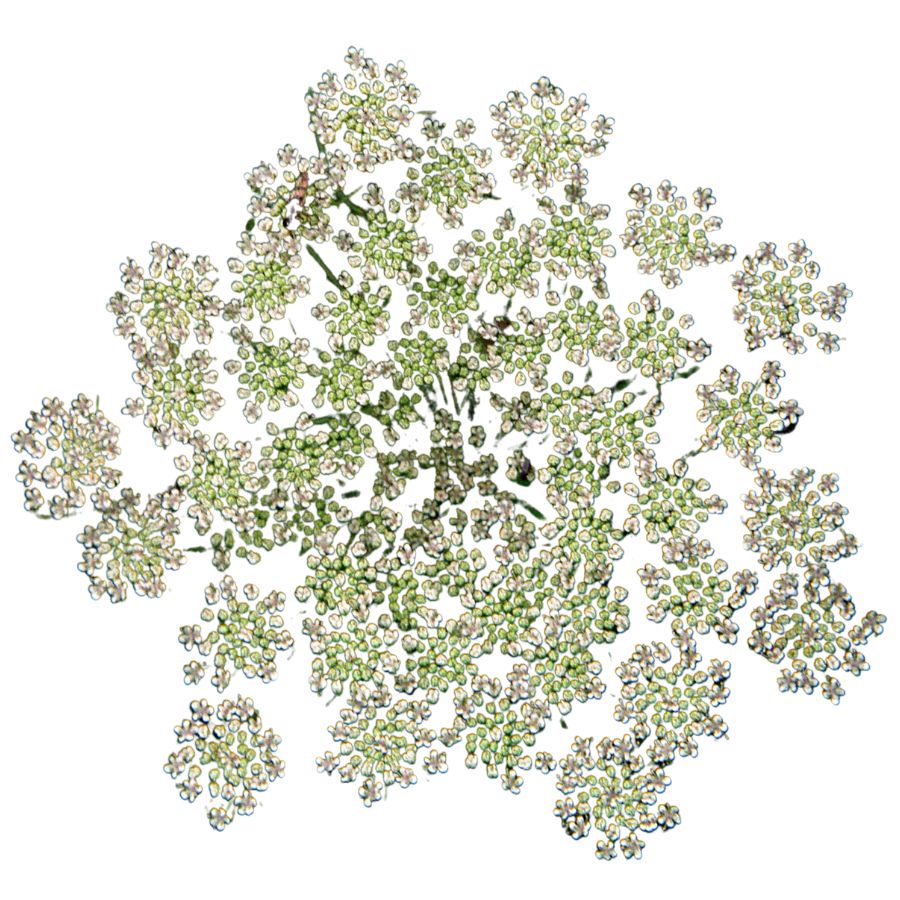
Often mistaken for: Wild parsnip (Pastinaca sativa) or wild celery (Apium spp.)
Water hemlock is a tall, branching plant with umbrella-shaped clusters of small white flowers. It grows in wet places like stream banks, marshes, and ditches, with stems that often show purple streaks or spots.
It can be confused with wild parsnip or wild celery, but its thick, hollow roots have internal chambers and release a yellow, foul-smelling sap when cut. Water hemlock is the most toxic plant in North America, and just a small amount can cause seizures, respiratory failure, and death.
False Hellebore (Veratrum viride)
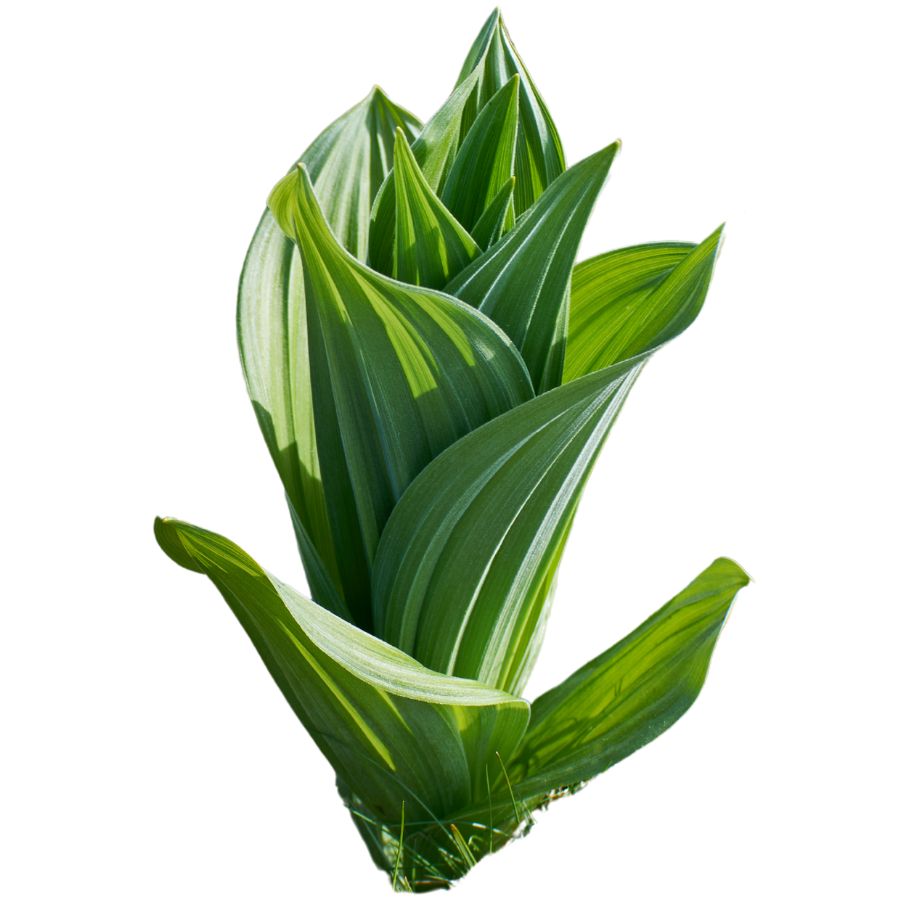
Often mistaken for: Ramps (Allium tricoccum)
False hellebore is a tall plant with broad, pleated green leaves that grow in a spiral from the base, often appearing early in spring. It grows in moist woods, meadows, and along streams.
It’s commonly mistaken for ramps, but ramps have a strong onion or garlic smell, while false hellebore is odorless and later grows a tall flower stalk. The plant is highly toxic, and eating any part can cause nausea, a slowed heart rate, and even death due to its alkaloids that affect the nervous and cardiovascular systems.
Death Camas (Zigadenus spp.)
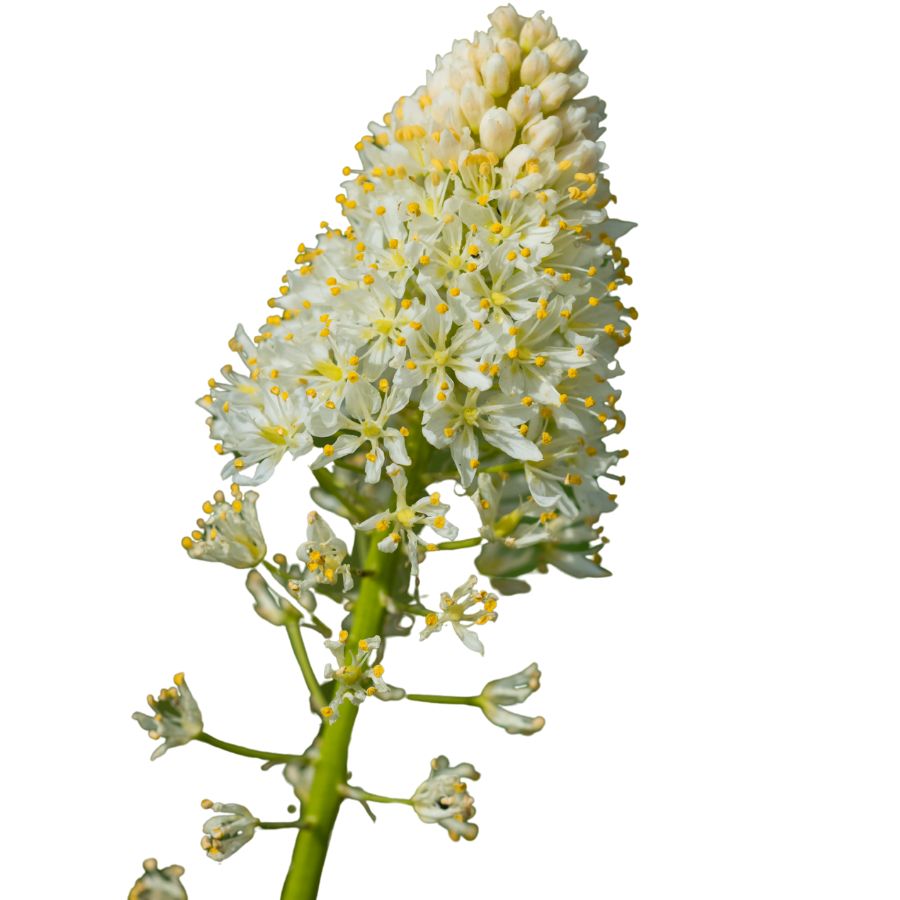
Often mistaken for: Wild onion or wild garlic (Allium spp.)
Death camas is a slender, grass-like plant that grows from underground bulbs and is found in open woods, meadows, and grassy hillsides. It has small, cream-colored flowers in loose clusters atop a tall stalk.
It’s often confused with wild onion or wild garlic due to their similar narrow leaves and habitats, but only Allium plants have a strong onion or garlic scent, while death camas has none. The plant is extremely poisonous, especially the bulbs, and even a small amount can cause nausea, vomiting, a slowed heartbeat, and potentially fatal respiratory failure.
Buckthorn Berries (Rhamnus spp.)
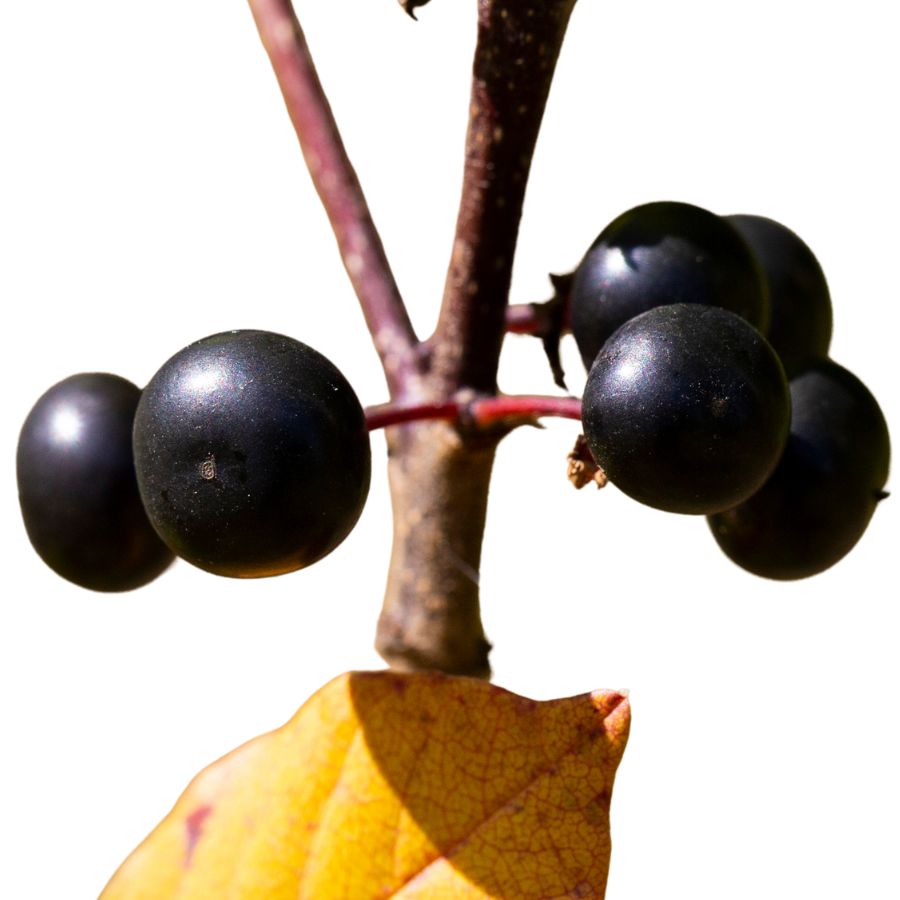
Often mistaken for: Elderberries (Sambucus spp.)
Buckthorn is a shrub or small tree often found along woodland edges, roadsides, and disturbed areas. It produces small, round berries that ripen to dark purple or black and usually grow in loose clusters.
These berries are sometimes mistaken for elderberries and other wild fruits, which also grow in dark clusters, but elderberries form flat-topped clusters on reddish stems while buckthorn berries are more scattered. Buckthorn berries are unsafe to eat as they contain compounds that can cause cramping, vomiting, and diarrhea, and large amounts may lead to dehydration and serious digestive problems.
Mayapple (Podophyllum peltatum)
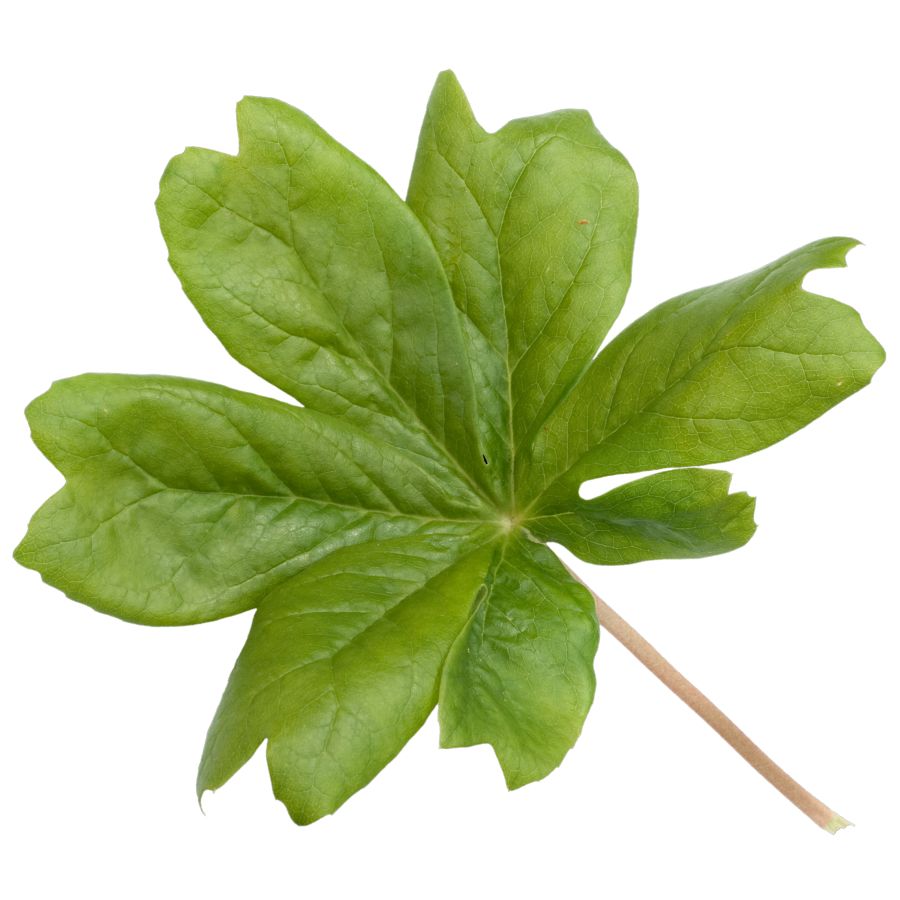
Often mistaken for: Wild grapes (Vitis spp.)
Mayapple is a low-growing plant found in shady forests and woodland clearings. It has large, umbrella-like leaves and produces a single pale fruit hidden beneath the foliage.
The unripe fruit resembles a small green grape, causing confusion with wild grapes, which grow in woody clusters on vines. All parts of the mayapple are toxic except the fully ripe, yellow fruit, which is only safe in small amounts. Eating unripe fruit or other parts can lead to nausea, vomiting, and severe dehydration.
Virginia Creeper (Parthenocissus quinquefolia)
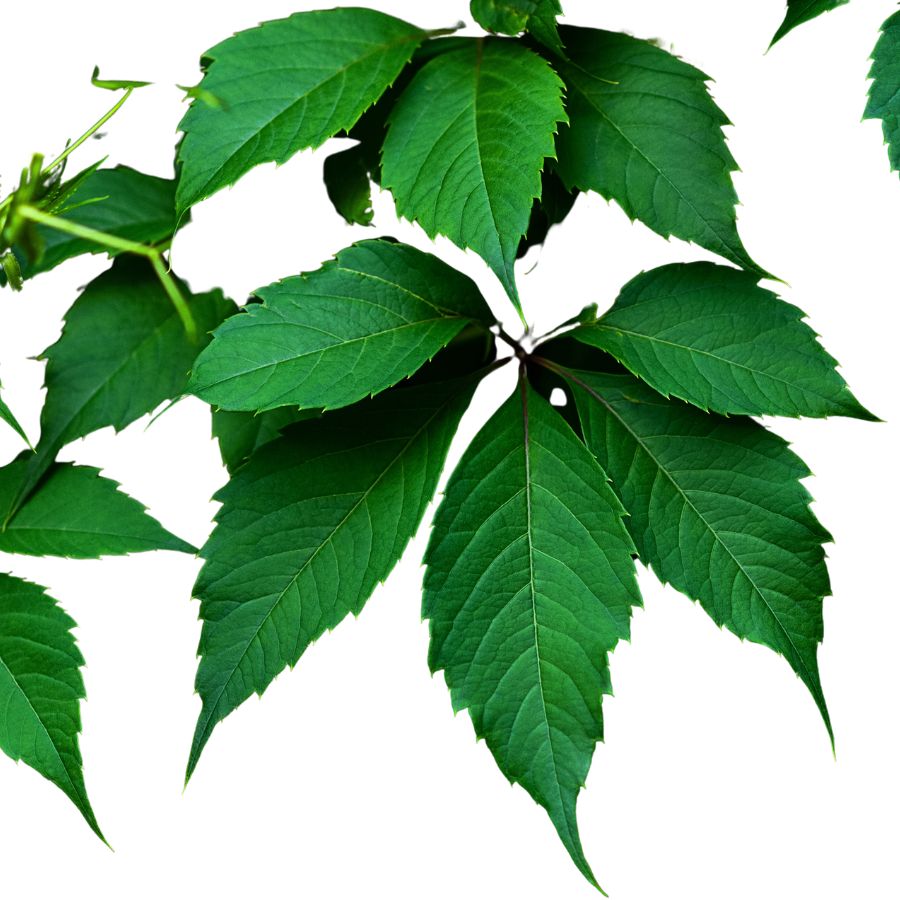
Often mistaken for: Wild grapes (Vitis spp.)
Virginia creeper is a fast-growing vine found on fences, trees, and forest edges. It has five leaflets per stem and produces small, bluish-purple berries from late summer to fall.
It’s often confused with wild grapes since both are climbing vines with similar berries, but grapevines have large, lobed single leaves and tighter fruit clusters. Virginia creeper’s berries are toxic to humans and contain oxalate crystals that can cause nausea, vomiting, and throat irritation.
Castor Bean (Ricinus communis)
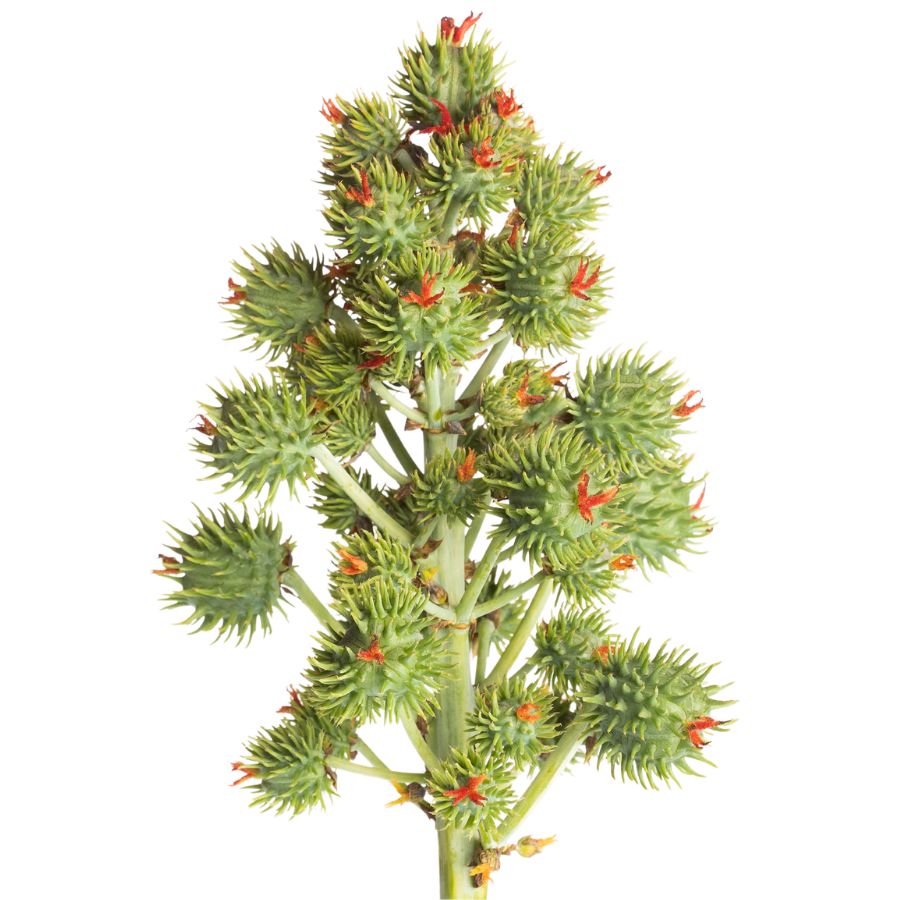
Often mistaken for: Wild rhubarb (Rumex spp. or Rheum spp.)
Castor bean is a bold plant with large, lobed leaves and tall red or green stalks, often found in gardens, along roadsides, and in disturbed areas in warmer regions in the US. Its red-tinged stems and overall size can resemble wild rhubarb to the untrained eye.
Unlike rhubarb, castor bean plants produce spiny seed pods containing glossy, mottled seeds that are extremely toxic. These seeds contain ricin, a deadly compound even in small amounts. While all parts of the plant are toxic, the seeds are especially dangerous and should never be handled or ingested.
A Quick Reminder
Before we get into the specifics about where and how to find these mushrooms, we want to be clear that before ingesting any wild mushroom, it should be identified with 100% certainty as edible by someone qualified and experienced in mushroom identification, such as a professional mycologist or an expert forager. Misidentification of mushrooms can lead to serious illness or death.
All mushrooms have the potential to cause severe adverse reactions in certain individuals, even death. If you are consuming mushrooms, it is crucial to cook them thoroughly and properly and only eat a small portion to test for personal tolerance. Some people may have allergies or sensitivities to specific mushrooms, even if they are considered safe for others.
The information provided in this article is for general informational and educational purposes only. Foraging for wild mushrooms involves inherent risks.
How to Get the Best Results Foraging
Safety should always come first when it comes to foraging. Whether you’re in a rural forest or a suburban greenbelt, knowing how to harvest wild foods properly is a key part of staying safe and respectful in the field.
Always Confirm Plant ID Before You Harvest Anything
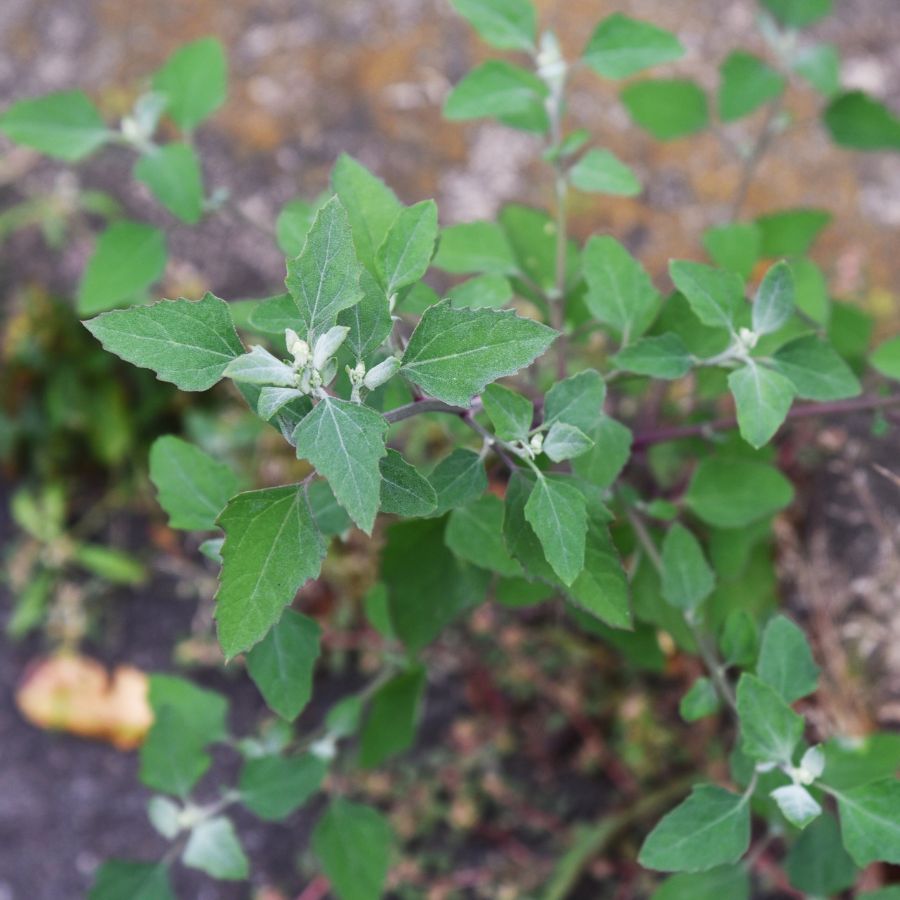
Knowing exactly what you’re picking is the most important part of safe foraging. Some edible plants have nearly identical toxic lookalikes, and a wrong guess can make you seriously sick.
Use more than one reliable source to confirm your ID, like field guides, apps, and trusted websites. Pay close attention to small details. Things like leaf shape, stem texture, and how the flowers or fruits are arranged all matter.
Not All Edible Plants Are Safe to Eat Whole
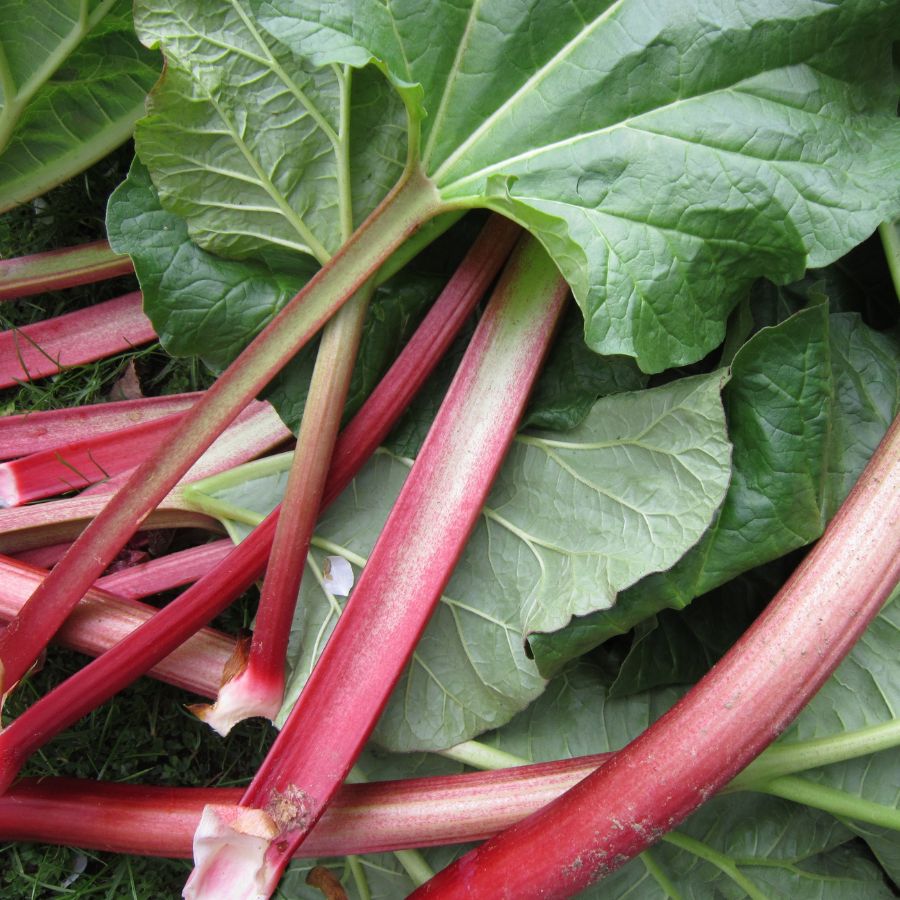
Just because a plant is edible doesn’t mean every part of it is safe. Some plants have leaves, stems, or seeds that can be toxic if eaten raw or prepared the wrong way.
For example, pokeweed is only safe when young and properly cooked, while elderberries need to be heated before eating. Rhubarb stems are fine, but the leaves are poisonous. Always look up which parts are edible and how they should be handled.
Avoid Foraging in Polluted or Contaminated Areas
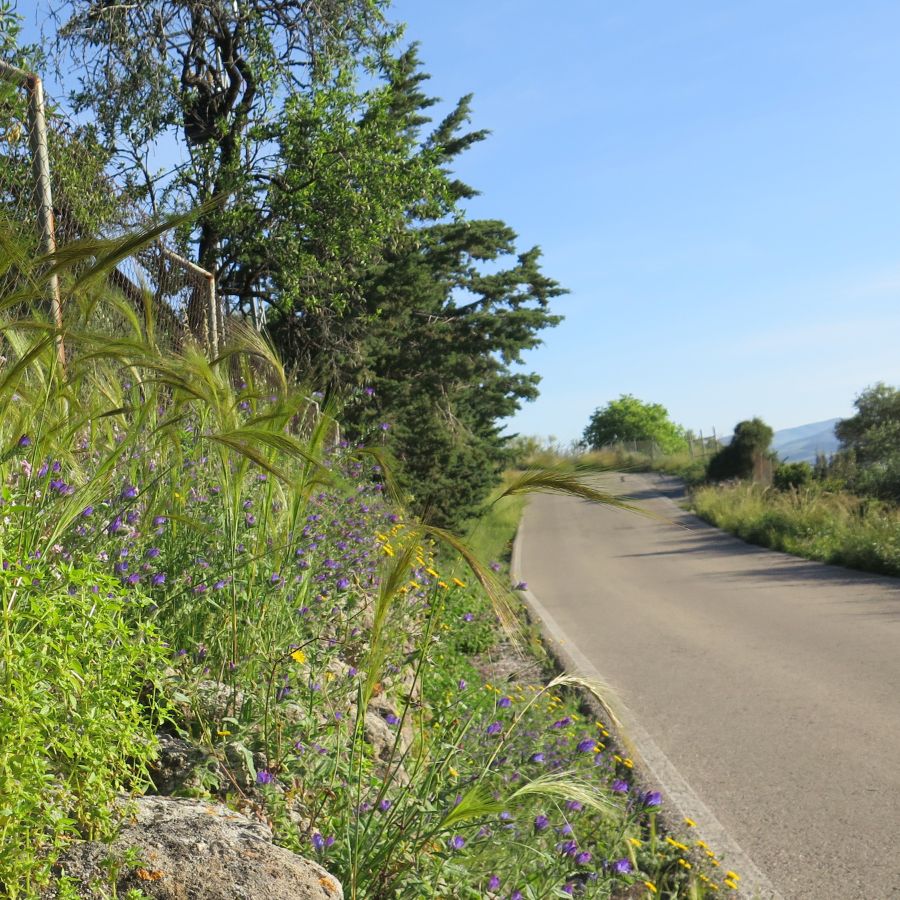
Where you forage matters just as much as what you pick. Plants growing near roads, buildings, or farmland might be coated in chemicals or growing in polluted soil.
Even safe plants can take in harmful substances from the air, water, or ground. Stick to clean, natural areas like forests, local parks that allow foraging, or your own yard when possible.
Don’t Harvest More Than What You Need
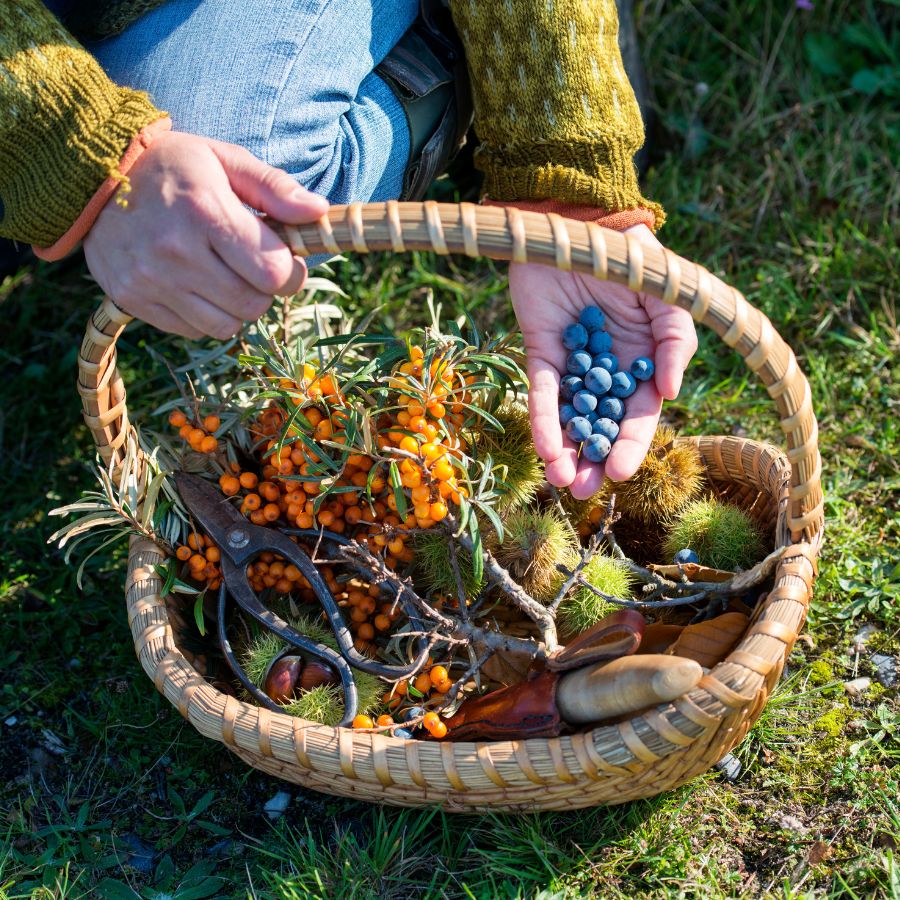
When you forage, take only what you plan to use. Overharvesting can hurt local plant populations and reduce future growth in that area.
Leaving plenty behind helps plants reproduce and supports wildlife that depends on them. It also ensures other foragers have a chance to enjoy the same resources.
Protect Yourself and Your Finds with Proper Foraging Gear
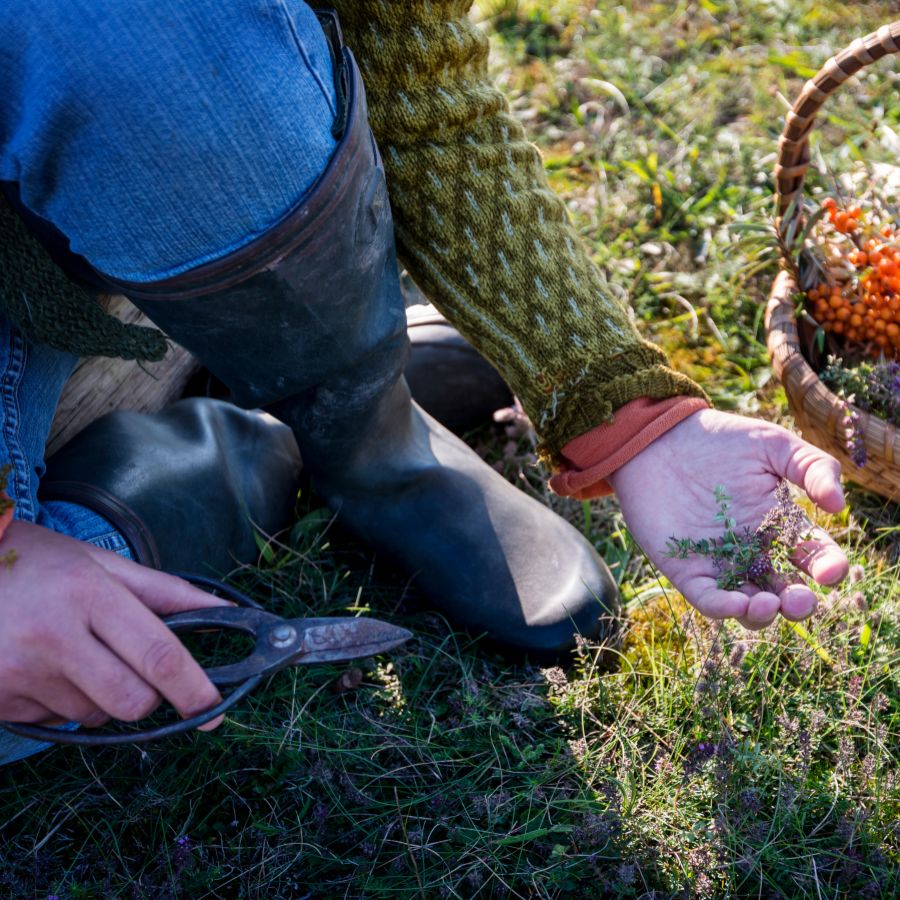
Having the right tools makes foraging easier and safer. Gloves protect your hands from irritants like stinging nettle, and a good knife or scissors lets you harvest cleanly without damaging the plant.
Use a basket or breathable bag to carry what you collect. Plastic bags hold too much moisture and can cause your greens to spoil before you get home.
This forager’s toolkit covers the essentials for any level of experience.
Watch for Allergic Reactions When Trying New Wild Foods

Even if a wild plant is safe to eat, your body might react to it in unexpected ways. It’s best to try a small amount first and wait to see how you feel.
Be extra careful with kids or anyone who has allergies. A plant that’s harmless for one person could cause a reaction in someone else.
Check Local Rules Before Foraging on Any Land
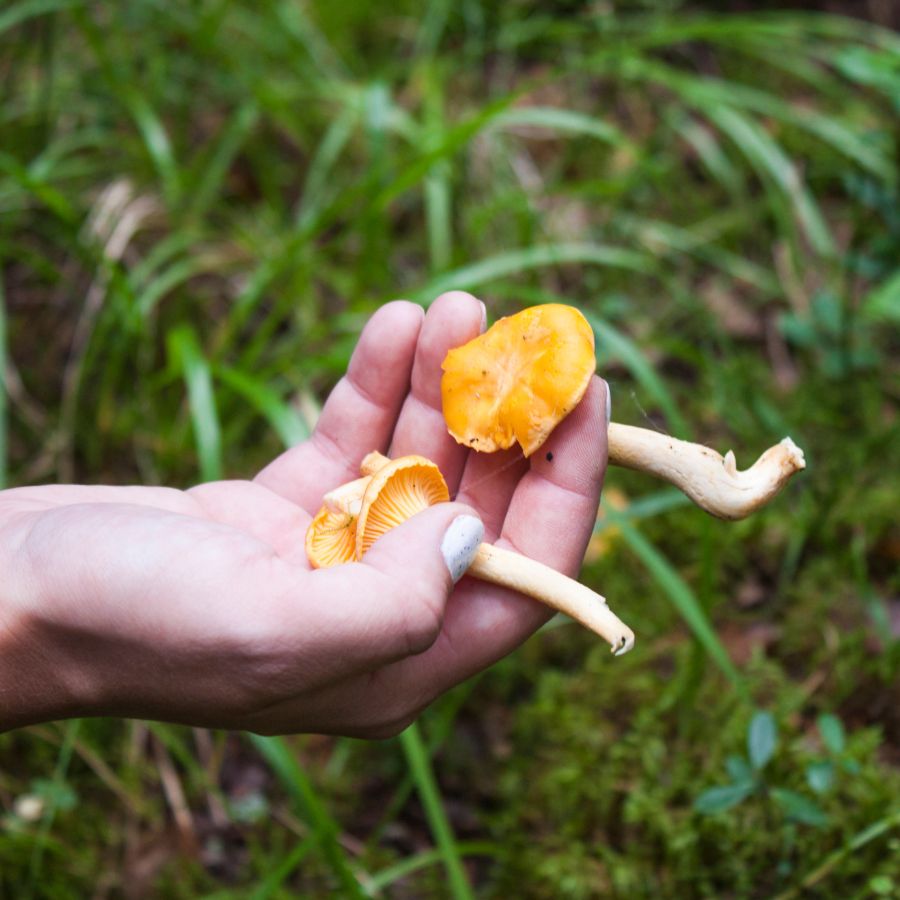
Before you start foraging, make sure you know the rules for the area you’re in. What’s allowed in one spot might be completely off-limits just a few miles away.
Some public lands permit limited foraging, while others, like national parks, usually don’t allow it at all. If you’re on private property, always get permission first.
Before you head out
Before embarking on any foraging activities, it is essential to understand and follow local laws and guidelines. Always confirm that you have permission to access any land and obtain permission from landowners if you are foraging on private property. Trespassing or foraging without permission is illegal and disrespectful.
For public lands, familiarize yourself with the foraging regulations, as some areas may restrict or prohibit the collection of mushrooms or other wild foods. These regulations and laws are frequently changing so always verify them before heading out to hunt. What we have listed below may be out of date and inaccurate as a result.
Where to Find Forageables in the State
There is a range of foraging spots where edible plants grow naturally and often in abundance:
| Plant | Locations |
| Wild Leek (Allium tricoccum) | – George Washington National Forest – Shenandoah National Park – Mount Rogers National Recreation Area |
| Wild Garlic (Allium vineale) | – Sky Meadows State Park – Richmond city lawns and parks – Shenandoah Valley meadows |
| Dandelion (Taraxacum officinale) | – James River Park System – Blue Ridge Parkway roadsides – Shenandoah Valley fields |
| Chickweed (Stellaria media) | – Urban gardens in Charlottesville – Shaded areas in Shenandoah National Park – Farm edges in Loudoun County |
| Sheep Sorrel (Rumex acetosella) | – Pine forests in George Washington National Forest – Sandy soils of Virginia Beach – Open fields in Prince William Forest Park |
| Curly Dock (Rumex crispus) | – Roadside areas in Augusta County – Wetlands near the Potomac River – Abandoned fields in Fairfax County |
| Milkweed (Asclepias syriaca) | – Fields in Shenandoah Valley – Meadows in Prince William Forest Park – Roadsides in Loudoun County |
| Groundnut (Apios americana) | – Wetlands along the James River – Stream banks in Shenandoah National Park – Marshy areas in Prince William Forest Park |
| Jerusalem Artichoke (Helianthus tuberosus) | – Fields near Monticello – Roadsides in Albemarle County – Edges of Shenandoah National Park |
| Mayapple (Podophyllum peltatum) | – Forest understories in Shenandoah National Park – Woodlands in George Washington National Forest – Shaded areas in Prince William Forest Park |
| Wild Grape (Vitis rotundifolia) | – Edges of George Washington National Forest – Along the Appalachian Trail – Wooded areas in Shenandoah National Park |
| Pawpaw (Asimina triloba) | – Bottomlands in Shenandoah National Park – Forested areas in Prince William Forest Park – Along the Potomac River in Fairfax County |
| Elderberry (Sambucus canadensis) | – Stream banks in Shenandoah Valley – Wetlands in George Washington National Forest – Edges of Prince William Forest Park |
| Spicebush (Lindera benzoin) | – Understory of Shenandoah National Park – Moist forests in George Washington National Forest – Shaded areas in Prince William Forest Park |
| Sassafras (Sassafras albidum) | – Wood edges in Shenandoah National Park – Abandoned fields in Loudoun County – Forests in George Washington National Forest |
| Carolina Rose (Rosa carolina) | – Meadows in Shenandoah Valley – Roadsides in Prince William County – Fields in George Washington National Forest |
| Black Walnut (Juglans nigra) | – Along the James River – Forests in Shenandoah National Park – Wooded areas in Fairfax County |
| Hickory (Carya tomentosa) | – Oak-hickory forests in Shenandoah National Park – Woodlands in George Washington National Forest – Prince William Forest Park |
| Beech (Fagus grandifolia) | – Moist forests in Shenandoah National Park – Slopes of George Washington National Forest – Wooded areas in Prince William Forest Park |
| Redbud (Cercis canadensis) | – Forest edges in Shenandoah Valley – Roadsides in Loudoun County – Woodlands in Prince William Forest Park |
| Stinging Nettle (Urtica dioica) | – Stream banks in Shenandoah National Park – Moist areas in George Washington National Forest – Wetlands in Prince William Forest Park |
| Wild Lettuce (Lactuca canadensis) | – Fields in Shenandoah Valley – Roadsides in Augusta County – Meadows in Prince William Forest Park |
| Smartweed (Persicaria pensylvanica) | – Wetlands along the Potomac River – Marshy areas in Fairfax County – Edges of Prince William Forest Park |
| Lamb’s Quarters (Chenopodium album) | – Gardens in Charlottesville – Abandoned fields in Shenandoah Valley – Urban areas in Richmond |
| Plantain (Plantago major) | – Lawns in Alexandria – Roadsides in Shenandoah Valley – Parks in Fairfax County |
| Wood Sorrel (Oxalis stricta) | – Forest floors in Shenandoah National Park – Gardens in Loudoun County – Shaded areas in Prince William Forest Park |
| Wild Bergamot (Monarda fistulosa) | – Meadows in Shenandoah Valley – Fields in Augusta County – Edges of George Washington National Forest |
| Common Mallow (Malva neglecta) | – Urban areas in Richmond – Gardens in Charlottesville – Roadsides in Fairfax County |
| Garlic Mustard (Alliaria petiolata) | – Forest edges in Shenandoah National Park – Woodlands in George Washington National Forest – Shaded areas in Prince William Forest Park |
| Ground Ivy (Glechoma hederacea) | – Lawns in Alexandria – Gardens in Richmond – Shaded areas in Fairfax County |
| Henbit (Lamium amplexicaule) | – Fields in Shenandoah Valley – Gardens in Charlottesville – Urban areas in Richmond |
| Purple Deadnettle (Lamium purpureum) | – Gardens in Alexandria – Lawns in Richmond – Fields in Fairfax County |
| Common Greenbrier (Smilax rotundifolia) | – Forests in Shenandoah National Park – Woodlands in George Washington National Forest – Edges of Prince William Forest Park |
| Cattail (Typha latifolia) | – Wetlands along the James River – Marshes in Fairfax County – Edges of Prince William Forest Park |
| Wild Strawberry (Fragaria virginiana) | – Meadows in Shenandoah Valley – Forest clearings in George Washington National Forest – Fields in Prince William Forest Park |
| Wineberry (Rubus phoenicolasius) | – Forest edges in Shenandoah National Park – Roadsides in Loudoun County – Woodlands in Prince William Forest Park |
| Blackberry (Rubus allegheniensis) | – Fields in Shenandoah Valley – Forest edges in George Washington National Forest – Meadows in Prince William Forest Park |
| Common Evening Primrose (Oenothera biennis) | – Roadsides in Augusta County – Fields in Shenandoah Valley – Meadows in Prince William Forest Park |
| Daylily (Hemerocallis fulva) | – Gardens in Richmond – Roadsides in Fairfax County – Urban areas in Charlottesville |
| Japanese Knotweed (Reynoutria japonica) | – Along the Potomac River – Roadsides in Fairfax County – Edges of Prince William Forest Park |
| Watercress (Nasturtium officinale) | – Streams in Shenandoah National Park – Springs in George Washington National Forest – Wetlands in Prince William Forest Park |
| White Clover (Trifolium repens) | – Lawns in Alexandria – Fields in Shenandoah Valley – Parks in Fairfax County |
| Red Clover (Trifolium pratense) | – Meadows in Shenandoah Valley – Fields in Augusta County – Roadsides in Prince William County |
| American Persimmon (Diospyros virginiana) | – Forests in Shenandoah National Park – Woodlands in George Washington National Forest – Fields in Prince William Forest Park |
Peak Foraging Seasons
Different edible plants grow at different times of year, depending on the season and weather. Timing your search makes all the difference.
Spring
Spring brings a fresh wave of wild edible plants as the ground thaws and new growth begins:
| Plant | Months | Best Weather Conditions |
| Wild Leek (Allium tricoccum) | March–May | Cool, moist forest floors after spring rains |
| Wild Garlic (Allium vineale) | March–May | Damp meadows or lawns with soft soil |
| Dandelion (Taraxacum officinale) | March–May | Sunny days after light rain in open fields |
| Chickweed (Stellaria media) | February–April | Cool, damp conditions in shaded areas |
| Curly Dock (Rumex crispus) | March–May | After rain in disturbed, sunny soil |
| Garlic Mustard (Alliaria petiolata) | March–May | Moist woodland edges with filtered light |
| Henbit (Lamium amplexicaule) | February–April | Cool weather, especially after light rains |
| Purple Deadnettle (Lamium purpureum) | February–April | Damp and partly sunny conditions |
| Redbud (Cercis canadensis) | March–April | Mild temperatures with partial sun |
| Mayapple (Podophyllum peltatum) | April–May | Moist, shaded woodlands during mild spells |
| Sassafras (Sassafras albidum) | March–May | Sunny forest edges after light rain |
| Wood Sorrel (Oxalis stricta) | April–May | Cool, damp soil with partial sunlight |
| Ground Ivy (Glechoma hederacea) | March–May | Moist lawns and meadows during cloudy weather |
| Watercress (Nasturtium officinale) | March–May | Flowing clean water, cool spring weather |
Summer
Summer is a peak season for foraging, with fruits, flowers, and greens growing in full force:
| Plant | Months | Best Weather Conditions |
| Milkweed (Asclepias syriaca) | June–August | Warm, sunny fields after early summer rains |
| Wild Grape (Vitis rotundifolia) | July–August | Hot weather following brief rain |
| Pawpaw (Asimina triloba) | August | Humid, warm days in shaded woods |
| Elderberry (Sambucus canadensis) | June–August | Warm, wet conditions along streams |
| Spicebush (Lindera benzoin) | July–August | Hot, humid forest edges |
| Black Walnut (Juglans nigra) | August | Warm, dry weather before fall drop |
| Hickory (Carya tomentosa) | August | Dry, warm days near woodlands |
| Beech (Fagus grandifolia) | July–August | Humid forest conditions with dappled light |
| Wild Lettuce (Lactuca canadensis) | June–August | Hot, humid fields after rain |
| Smartweed (Persicaria pensylvanica) | July–September | Wetlands or ditches after rain |
| Lamb’s Quarters (Chenopodium album) | June–August | Sunny days with rich, moist soil |
| Plantain (Plantago major) | June–August | Warm, open areas with disturbed soil |
| Wild Bergamot (Monarda fistulosa) | July–August | Hot, dry days in open meadows |
| Common Mallow (Malva neglecta) | June–August | Warm, dry patches of soil in disturbed areas |
| Common Greenbrier (Smilax rotundifolia) | June–August | Sunny woodland edges after rain |
| Cattail (Typha latifolia) | June–August | Warm, sunny wetland margins |
| Wild Strawberry (Fragaria virginiana) | May–June | Mild sunny mornings after spring showers |
| Wineberry (Rubus phoenicolasius) | June–July | Warm, humid days along forest trails |
| Blackberry (Rubus allegheniensis) | June–August | Hot, sunny thickets after light rains |
| Daylily (Hemerocallis fulva) | June–August | Sunny roadsides and open lawns |
| Japanese Knotweed (Reynoutria japonica) | May–July | Moist riverbanks in full sun |
| White Clover (Trifolium repens) | May–August | Sunny lawns and meadows after rainfall |
| Red Clover (Trifolium pratense) | May–August | Humid fields with moderate sunlight |
| Carolina Rose (Rosa carolina) | May–July | Warm, sunny meadows with occasional rain |
| Stinging Nettle (Urtica dioica) | May–July | Moist shaded soil with recent rainfall |
Fall
As temperatures drop, many edible plants shift underground or produce their last harvests:
| Plant | Months | Best Weather Conditions |
| Groundnut (Apios americana) | September–November | Damp riverbanks in cool, overcast weather |
| Jerusalem Artichoke (Helianthus tuberosus) | September–November | Dry fields following late summer sun |
| American Persimmon (Diospyros virginiana) | September–November | Cool mornings after warm days |
| Spicebush (Lindera benzoin) | September–October | Moist woodlands under mild skies |
| Black Walnut (Juglans nigra) | September–October | Breezy dry days before leaf drop |
| Hickory (Carya tomentosa) | September–October | Dry forested areas with leaf litter |
| Beech (Fagus grandifolia) | September–November | Cool forests during early leaf fall |
| Sassafras (Sassafras albidum) | September–October | Warm, dry afternoons with leaf color change |
| Cattail (Typha latifolia) | September–October | Cool, sunny weather in wetland edges |
Winter
Winter foraging is limited but still possible, with hardy plants and preserved growth holding on through the cold:
| Plant | Months | Best Weather Conditions |
| Dandelion (Taraxacum officinale) | December–February (mild spells) | Sunny breaks during mild winter days |
| Chickweed (Stellaria media) | December–February | Cool, damp winter patches with partial sun |
| Henbit (Lamium amplexicaule) | December–February | Mild winter days after light rain |
| Purple Deadnettle (Lamium purpureum) | December–February | Moist, cool soil in urban and rural areas |
| Ground Ivy (Glechoma hederacea) | December–February | Overcast, wet conditions near disturbed soil |
| Wild Garlic (Allium vineale) | January–February | Warmer days with moist soil in open areas |
| Watercress (Nasturtium officinale) | December–February | Flowing freshwater springs, above freezing temps |
One Final Disclaimer
The information provided in this article is for general informational and educational purposes only. Foraging for wild plants and mushrooms involves inherent risks. Some wild plants and mushrooms are toxic and can be easily mistaken for edible varieties.
Before ingesting anything, it should be identified with 100% certainty as edible by someone qualified and experienced in mushroom and plant identification, such as a professional mycologist or an expert forager. Misidentification can lead to serious illness or death.
All mushrooms and plants have the potential to cause severe adverse reactions in certain individuals, even death. If you are consuming foraged items, it is crucial to cook them thoroughly and properly and only eat a small portion to test for personal tolerance. Some people may have allergies or sensitivities to specific mushrooms and plants, even if they are considered safe for others.
Foraged items should always be fully cooked with proper instructions to ensure they are safe to eat. Many wild mushrooms and plants contain toxins and compounds that can be harmful if ingested.

